by Veronica Peek
…
…
Chapter 1: farewell to old England
John Ireland went to sea in 1833 and became a famous ship’s boy. For decades, seafarers resigned to the terrors of typhoons and shipwrecks, linked his name to their worst nightmares and darkest fears. What happened to him had a tragic impact on Australia’s development as a nation, with frightful and bloody retaliation the inevitable consequence.
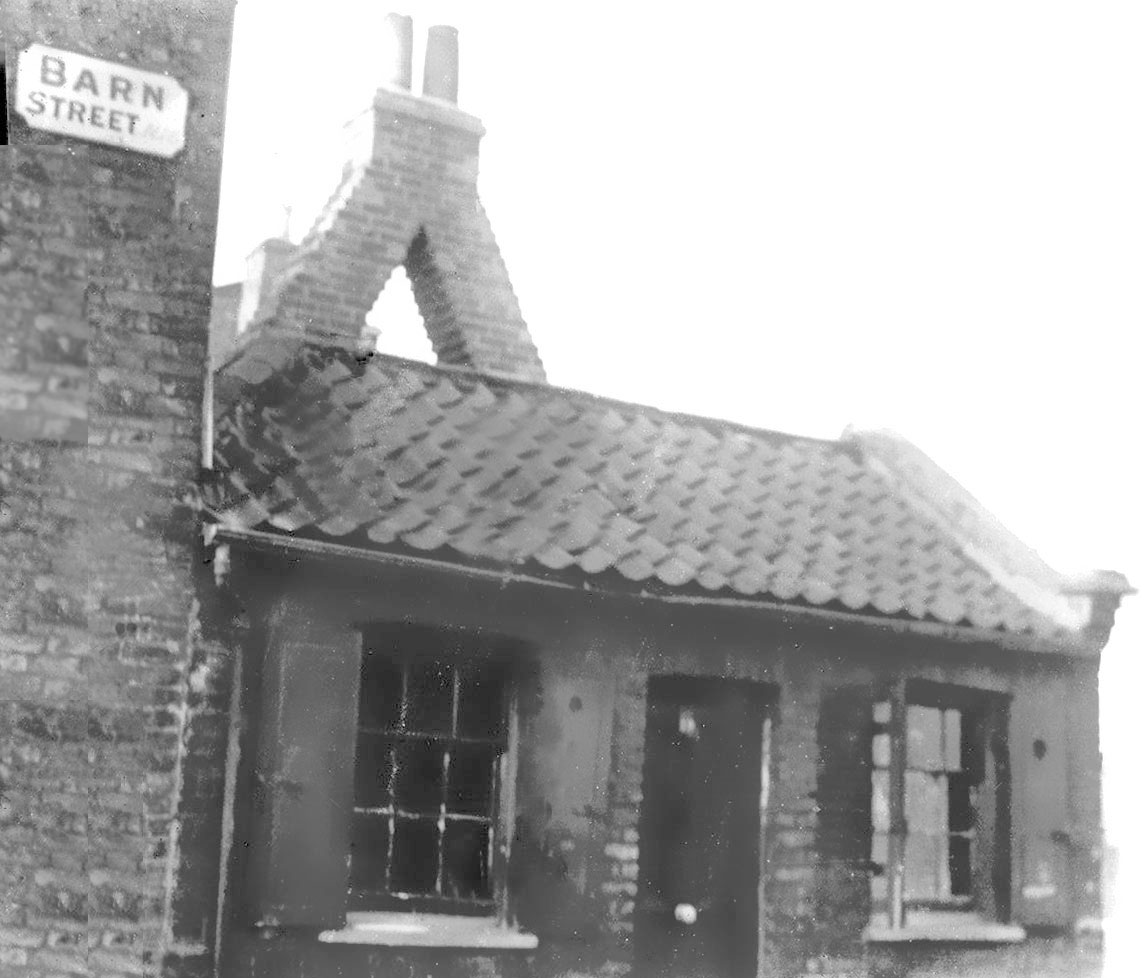
His story began to unfold in September 1833, when he set off through London’s streets to St Katharine’s Dock on the River Thames. At one of the dockyard’s moorings was a new barque in need of a boy to assist with the fit out and John had just been hired for the job. He was leaving behind his parents, George and Charlotte Ireland,1 at Stoke Newington,2 a village about three miles from the London post office on the verge of becoming a suburb. Wealthy merchants had discovered it as a rural retreat close to the city, and were lining its main roads with mansions. John’s parents, however, lived at 7 Barn Street,3 one of the oldest streets in the village. Their home near the corner of busy Church Street was part of a row of workers cottages. By 1832 the entrance to St Mary’s parish school was in Barn Street, a few doors from the Ireland house. It taught about 110 students at any given time, in an antiquated building shaded by trees.4
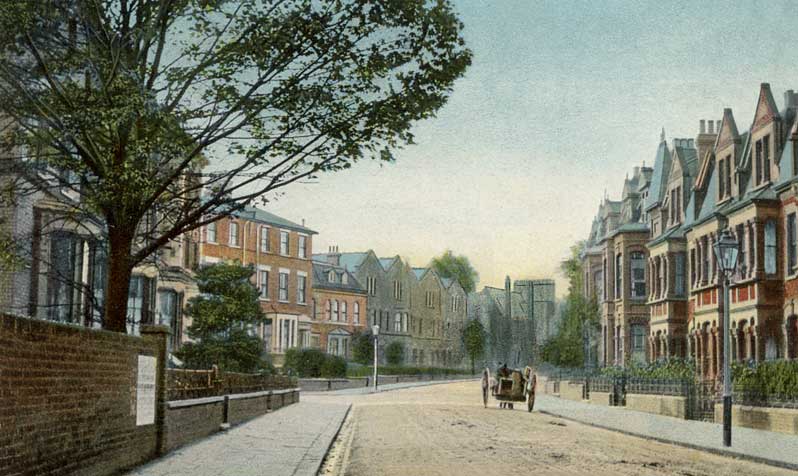
John should have received some education, yet his numeracy and literacy skills were poor. Dispatching sons of employment age to the merchant marines was a stock solution for cash-strapped parents, willing to ignore all that talk of savage beatings and watery graves. More often, the boys themselves had dreams of escaping quiet schoolrooms or raucous rookeries for a sailor’s life on the waves.
John was born on Christmas Day, 1818, and christened on 17 January 1819 at the old St Mary’s Church in Stoke Newington.5 He would later describe his parents as ‘aged’ (Sydney Herald 27 Oct. 1836) but in 1833 they were still in their thirties.6 George was a bricklayer, making a living from the new housing estates springing up in the area. He had five surviving children to support, ranging in age from John, who was approaching 15, to baby Eliza.7 His oldest son, George Jnr, was already an apprentice printer.
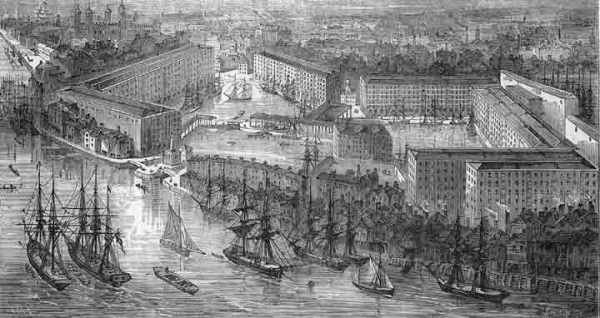
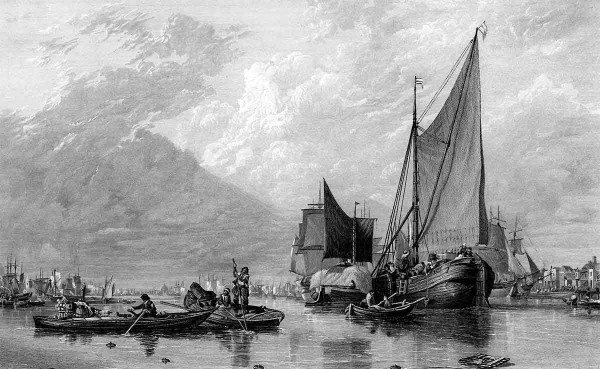
When John passed through St Katharine’s gate and saw the Charles Eaton for the first time, he had no reason to be displeased. She was a fine-looking barque, registered at 314 tons to carry 350 tons burden,8 and was about to embark on her first real trading venture to the Australian penal colonies, having just arrived from a shipbuilding yard at Coringa, near Madras in India. She was named after Captain Charles Eaton, a former port master at Coringa.9

Advertised for sale soon after her arrival in London, she was described in the Guardian and Public Ledger (6 Sept. 1833) as having: “two flush decks, forecastle, bust head and quarter galleries, and is coppered to the wales in chunam [lime plaster] and felt”, the latter two being a common base for the copper sheathing of hulls. Her most attractive feature for first-class passengers was two quarter galleries, common on the large merchant ships servicing the Honourable East India Company (HEIC), but much less so on small merchant vessels the size of the Charles Eaton. Externally, they added extra decorative touches to the sides of the ship’s stern; internally they were usually tiny windowed WCs (water closets) with their toilet holes projected out over the sea. They were an extra luxury and could only be used by the occupants of the two largest poop cabins at the stern. The respectable shipping company, Gledstanes & Co, accustomed to such features on India-bound ships perhaps, wasted no time in adding the India-built Charles Eaton to their fleet. She was lovely to look at and acceptable by the standards of her day, but she was not particularly seaworthy. British-designed merchant ships had deep, flat-bottomed hulls and holds capable of carrying cargo well in excess of their registration. When blown by the wind towards a lee shore or reef they responded slowly to any efforts to alter course, with potentially dire consequences for all aboard them.
John was one of the first of the new crew hired for the forthcoming voyage, his wage being no more than a few shillings a week.10 Since her arrival from Coringa the barque had been without a master. Captain Frederick George Moore, ex-EIC, had now filled the vacant post. John was the apprentice steward but in the meantime, he had to run messages, scrub decks, stoke fires and fill water casks. As far as his employers were concerned, he was a cabin boy, with whatever additional duties that role entailed. The rest of the crew came aboard when departure was imminent. Tom Haviside was the shipping agent and he placed the following notice in the 5 October 1833 edition of The Times:
For Van Diemen’s Land. – To sail on the 1st of November direct for Van Diemen’s Land and Sydney, the fine new teak ship Charles Eaton, burden 350 tons, F. Moore, late of H.C.S., Commander—lying in the St. Katharine Dock. This ship has superior poop accommodation, and 6 feet 6 inches heights between decks, having been built expressly for passengers, is well manned and armed, and carries a skilful surgeon. For freight or passage apply to the Commander, on board; or to T. Haviside and Co., 147 Leadenhall street.
Gledstanes & Co., the barque’s new owner, already had a fleet of East Indiamen servicing India and China.11 The Charles Eaton was its newest and smallest vessel and the right choice to test the Australian market.12 The broker began advertising her with great vigour but passenger bookings were slow.
One cabin passenger who did book early was a young, London-based lawyer, George Armstrong.13 Irish-born Armstrong was about 25 years old and acquainted with Captain Moore through Gledstanes or a mutual friend.14 He was planning to set up a practice at Canton in China. Taking the long route via Australia aboard a potential client’s new ship was a smart move. Gledstanes was venturing into the lucrative Canton market and would need an agent there. Armstrong invested in a quantity of wine and added it to the cargo in the hold. He would easily sell all of it at Sydney.15
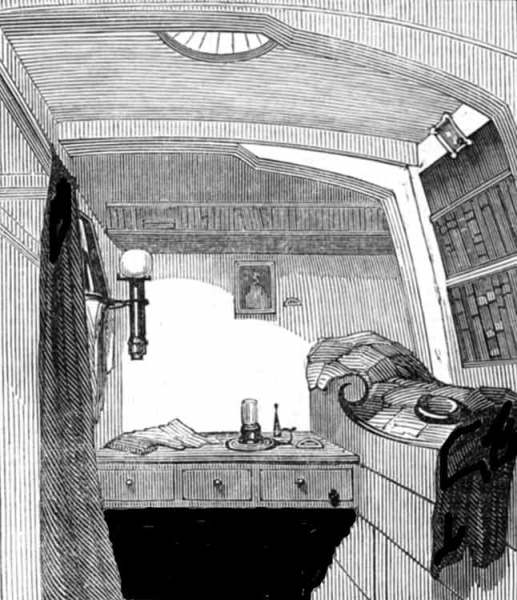
Throughout October and November 1833, the broker received bills of lading for cargo booked to the barque. A large quantity of calico bales and 410 lead ingots came from Messrs Gledstanes, Drysdale and Co.,16 a merchant arm of the owner company. It was common for ship owners to top up their holds with their own speculative cargo when there were insufficient paid consignments. Gledstanes entrusted its cargo to Captain Moore, who would sell or barter it as the opportunity arose. His background with the EIC’s merchant navy adequately equipped him for that role.17 Elsewhere in the hold were stacks of alcohol for Sydney – puncheons, cases, casks and hogsheads of wine, brandy and port.18 The rest of the space was filled with sundry cargo, ship’s stores and passengers’ goods, including quite possibly a piano. The Hull family of London had chosen the Charles Eaton for their emigration voyage to South Africa and Mrs Sophia Hull and her two oldest daughters were talented pianists.19
Then came the happy news that the Children’s Friend Society had booked steerage passages for 40 orphans to the Cape of Good Hope.20 The Society had already shipped six batches of children to Cape Town and was wasting no time in sending more.21 Only some of the children were orphans; many had one or both parents living. They had come to the Society because their parents were either destitute, negligent, or could no longer control them. Some of the boys already had convictions for petty offences, and the Society had rescued them from a reform school.22
Most of the boys, however, were coming from the recently established Brenton Asylum at Hackney Wick – a village adjacent to Stoke Newington – where they were given an elementary education, but also taught gardening, domestic chores and other useful skills such as basic bricklaying and carpentry. The Asylum also had ‘a rope-walk round the yard, and a mast; for the pupils were trained for sea’.23
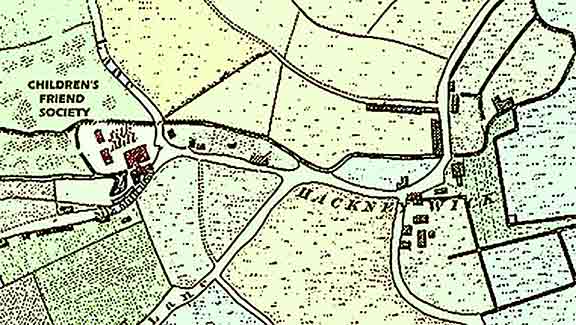
One day in early December, John was climbing the barque’s superstructure of ropes and spars when he fell into the polluted waters of the dock. The chief mate, Frederick ‘Fred’ Clare, instantly dived into the water and saved him from drowning. John needed a hero and he got one. Thereafter he would never speak a bad word against the chief mate.24 Clare was 29 years old and a first-rate officer. He had travelled from India on the barque’s maiden voyage as the second mate, but since had a promotion to chief mate.25 His father was the Rev. John Clare, now widowed and semi-retired to the Wolverhampton Deanery in Staffordshire.26 The Rev. Clare’s loving influence made it inevitable that Christian faith would govern his son’s actions. One day the chief mate would make an excellent captain. In his present performance was that promise for his future.
The newly appointed second mate, William Mayor, was a Londoner with a sister who would soon be emigrating to Australia with her family,27 while the ship’s surgeon was listed on crew manifests simply as F. or R. Grant. Captain Moore, meanwhile, had been hiring his crew. Ten general hands signed on with their standard sea-kits – a pannikin, one or two utensils, a change of clothes and a thin straw mattress. Their identifying uniform was still their wet-weather tarpaulin, a tar-coated hat sometimes fashioned as a sou’wester. Their duck trousers were firm on the hips and loose at the ankles, while woollen pea jackets were comfortable for men who spent their working hours climbing rigging.28 Reputation branded them as uncouth. They had to put up with tough and tasteless rations and a fair amount of savage persecution from the captain and his mates on the quarterdeck. The cramped and crowded forecastle (fo’c’s’le) where they ate and slept was also a hotbed of gossip about the captain, the passengers and anyone who had some control over privileges. Shipboard journals, usually kept by passengers, have typically described ships’ crews as either decent enough as sailors go, or ‘as bad a set of lubbers as ever worked a ship’.29
In Leadenhall Street, not far from St Katherine’s Dock, there was at that time a wine shop and wholesaler partly owned by John Wardell. It catered for sailors and stevedores and Captain Moore was a regular customer. So much so, that John Wardell and his brother, William, were his closest friends. Ex-EIC Moore was accustomed to private trading and may have encouraged George Armstrong to do the same. On the 13 December 1833, he entrusted his last will and testament to the Wardell brothers.30 In it he left most of whatever he owned at the time of death to his ‘excellent mother’ if then alive, otherwise brother James if then alive, otherwise his two sisters likewise.
One week later, on 20 December, Moore apparently wrote and signed a codicil appointing William Wardell and a business partner, Alex Gibbs, as the executors of his will. William Wardell would later say of Moore that he was a man of ‘known intelligence and enterprise’.31 The image that emerges from Wardell’s own sworn version of events is rather that of a man who was pre-occupied with finalizing his private affairs when he should have been preparing his ship for departure.32 Moore had formerly been a second officer aboard the East Indiaman George IV,33 but had recently left the Company’s service, voluntarily or otherwise. The EIC was about to lose its trading monopoly over India and China, and was already selling off merchant ships and sacking their seamen and officers, in anticipation of the inevitable reduction in its trade. Moore had returned to London and taken rooms at 26 Charles Street, Saint James Square. He was a middle-aged bachelor, and lived alone.
For a period of about 13 years, from 1830 till 1843, the aforementioned William Wardell was the proprietor of the Equestrian Coffee House at 124 Blackfriars Road, Surrey, usually with the help of business partners who came and went, doubtless taking what was left of their investment with them. It was next door to the Surrey Theatre, which hosted equestrian displays for a time, hence the name. Like many coffee houses, it was also run as a gentlemen-only club for its own regular clientele, with club facilities and private rooms. Captain Moore would have been a comparatively solitary figure, a stranger in his home city after so many long absences at sea. It’s easy to understand why he was attracted to Wardell’s coffee house.
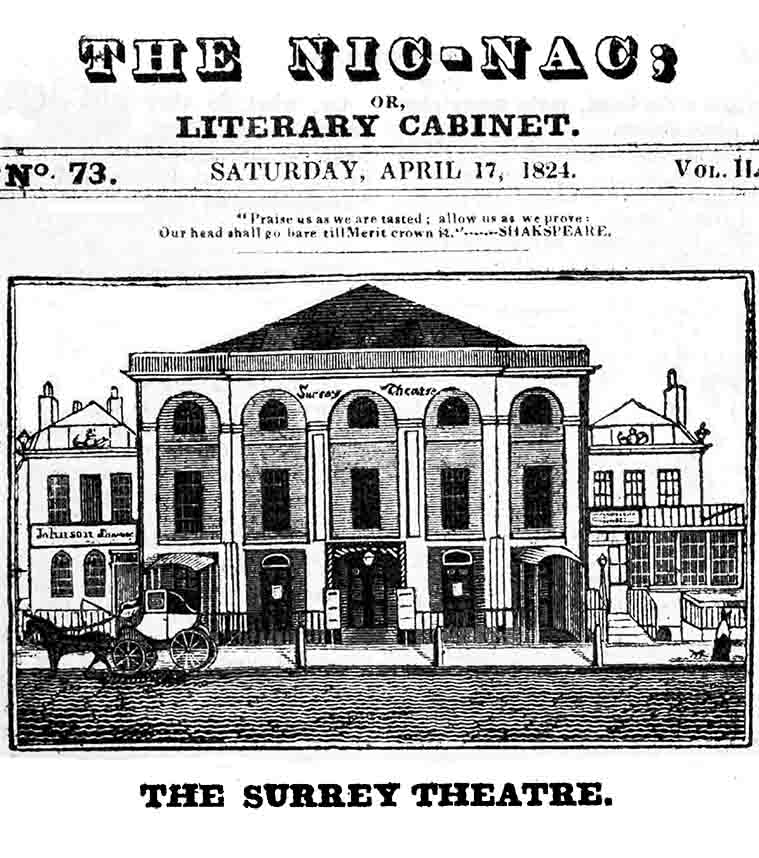
The young Irish bachelor, George Armstrong, may also have been a newcomer to London in search of compatible company at the coffee house. His friendship with the older and more worldly ship’s master may have blossomed over pots of ale at ye olde Equestrian. In any event, all thoughts of a London practice were abandoned. Armstrong chose instead to embark on an exciting and life-changing adventure with dreams of amassing a fortune from China tea, perhaps with the help of a few hometown Irish investors.
It had taken Moore only a few months to find work as the master of the Charles Eaton. Ship owners were finding it difficult to hire experienced men to captain their ships on voyages to Australia and were snapping up ex-EIC officers. It was a big promotion from second officer to ship’s master, especially for someone who had never been to Australia. Moore did, however, buy a copy of Horsburgh’s 1832 chart Passages through the Great Barrier Reef. He was worried about the accuracy of some of the charts for his forthcoming route. That sense of his own mortality is reflected in his will and testament, with its emphasis on past sins and God-willing salvation. He described no specific assets in it, apart from £400 to his brother, but EIC ships officers usually made a good second income from private trade. The last-minute scrappy codicil seems dodgy and may have been dreamed up to expedite the will for the benefit of Moore’s aged mother. You could also argue that it simplified the payment of creditors’ claims. Gledstanes knew nothing of it and continued to assume that they were Moore’s executors.
On 19 December 1833, with the winds finally favourable, the Charles Eaton sailed. The waifs from the Children’s Friend Society had boarded at London on 10 December, presumably with Mrs Sophia Hull, who would supervise the girls. The barque reached the Downs on 23 December, where she collected the bulk of her passengers.
The rest of the passengers for Cape Town and Australia now embarked, bringing with them their portable trunks, bedding, washbasins and other items recommended by the booking agent, such as sand and sandstone bricks, used for scrubbing down steerage decks. The bulk of their larger baggage had been loaded at London. The waifs numbered 18 girls and 22 boys and they ranged in age from 9 to 14. At least an additional 13 steerage passengers, including children, were going to Australia, although the real number was probably higher. Published passenger lists for steerage were sketchy at best.34 Most of them had travelled to the coastal village of Deal, in Kent, booking into boarding houses until it was time to board their ship, lying at anchor in the Downs, the roadstead for the English Channel. On any given day, there were usually dozens – but sometimes hundreds – of masters and commanders patiently waiting for the right winds to blow their ships safely through the dangerous waterway.
Sophia Hull probably embarked at London, while her husband, Henry, their eight children and Henry’s sister, Katharine Hull, embarked at Deal.35 Sophia was supervising the female juveniles from the Children’s Friend Society and had already hired one of them as a servant, while another girl, having presumably just lost or given up her own infant, was engaged as a wet nurse for Sophia’s baby.36
After a two-day stopover, the Charles Eaton weighed anchor for the Channel. Christmas day – and John’s 15th birthday – was passed quietly while they were still off the village of Deal, with many of the passengers too busy vomiting into their washbasins to care tuppence about special treats. They were too seasick to do anything at all, let alone cook and eat a rich pudding.37

On 27 December the barque arrived at Cowes on the Isle of Wight, but was detained once more by unfavourable winds. Eight days later she quit the port, and was passing by the rocky outcrop known as the Needles when she collided with a schooner, which struck her across the bow, breaking off the bowsprit mast. ‘This accident caused great alarm among the passengers,’ commented the cabin boy, John Ireland, many years later, ‘and more especially among the children.’38 Well yes but the news when they received it in London must have alarmed the Messrs Gledstanes as well. There was nothing they could do about it though, except cross their fingers and hope they had hired the right master.
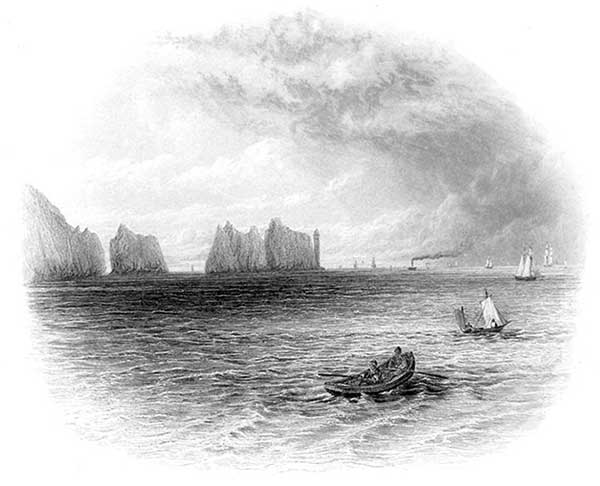
The accident forced the barque back to Cowes until the ship’s American carpenter, 33-year-old Laurence Constantine, had repaired the bowsprit and replaced the jib boom. As for the schooner, she was beyond repair. She made it back to Cowes but never put to sea again. The unexpected delay made it inevitable that some of the passengers would make up shore parties and put one of the small boats to use as a ferry. Captain Moore came back one day with a Newfoundland dog called Portland. As ship’s dogs go, he was a good choice. Newfoundlands are large and shaggy, but also intelligent, docile, and outstanding long-distance swimmers, known to have saved people washed overboard. The ship carried the usual caged livestock, but Portland would have ranked much higher in the entertainment stakes with the children.

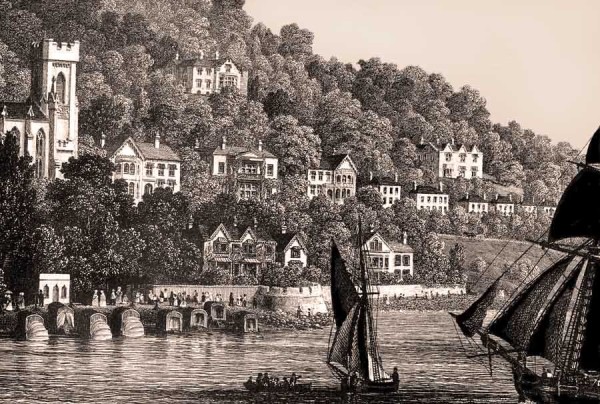
For a vessel to have an accident while leaving port on a maiden voyage was a particularly bad omen. There is no reason to believe, however, that while the children were aboard it, the barque was anything other than a happy ship. The voyage was their last chance to savour the remnants of their childhood. Unfortunately for the young seafarers there were further delays when storms lashed England’s southern coast, forcing all ships to take refuge in ports.39 For the seamen, dressed in their waterproof hats and jackets, the daily routine of rotating four-hour watches continued unabated. For the passengers, it must have been a torture of boredom and discomfort. Only when the swells had moderated would they have ventured up on deck, to stretch their limbs and blink at rain-drenched Cowes.
When John Ireland had hugged his baby sister, Eliza, before his ship sailed, it really was a last farewell. While he was still sogging it out in Cowes, Eliza died aged 16 months.40 Perhaps that drenching winter was the death of her. It would be many years before the cabin boy caught up with the news. His suffering parents had now buried two daughters called Eliza in the graveyard at Stoke Newington’s St Mary’s church.
On 1 February 1834, the barque finally got under way again. She arrived at Falmouth in Cornwall four days later and loaded more cargo, plus at least one more steerage passenger. Eight days later the barque was underway ‘with a good wind, and every prospect of a happy voyage,’ according to John.41 What joy and relief for everyone but especially for the captain, who had to account for expenses. It had taken his ship seven weeks to quit England’s shores and there were well over 100 people on board, rapidly eating their way through the rations.
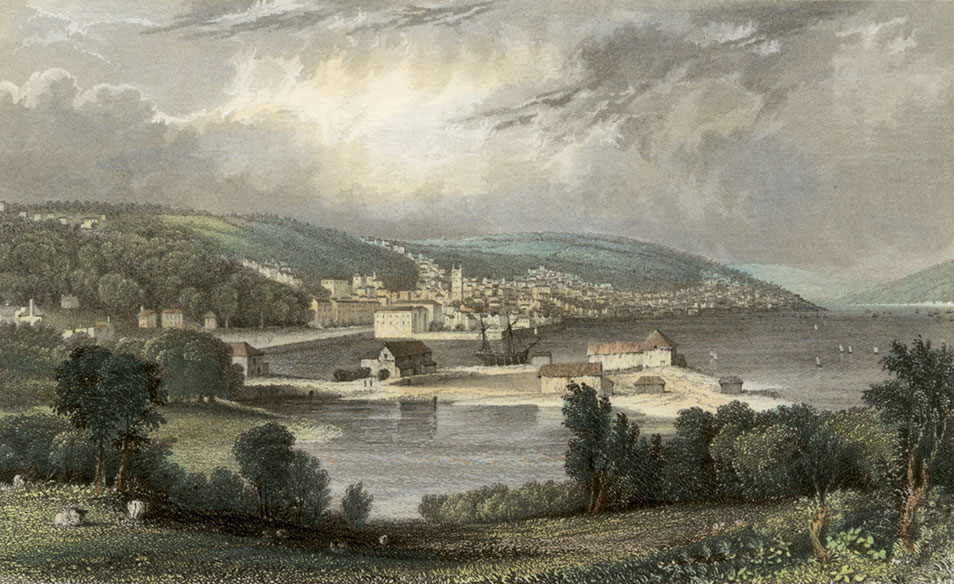
Header Image: Oil painting (1841) by John Wilson Carmichael, commissioned by William Bayley, the uncle who subsequently adopted and raised William D’Oyly. Portrays the moment when five canoe loads of Murray islanders escorted William out to the colonial schooner Isabella. Held by the National Gallery of Australia. I have taken the liberty of reproducing it here in what I hope is its original, unvarnished colour tones.
..Notes to Chapter 1
- UK Census, 1841.
- Ireland’s London deposition, The Times, 31 Aug. 1837.
- Ireland, The Times, 31 Aug. 1837.
- The 1848 tithe map for Stoke Newington has a good image of Barn Street and its little worker cottages. John described it as being on the corner of Church Street, which locates it almost exactly.
- International Genealogy Index (IGI), St Mary’s birth and christening records.
- Sydney Herald, 27 Oct., 1836.
- Birth and baptism records from St Mary’s Stoke Newington, give us the following offspring for George and Charlotte in 1832: George, born 1817; John 1818; Eliza 1824, d. 1825; Charlotte 1826; Mary 1828; James 1830; Eliza 1832 (died 1834).
- Lloyd’s Register of British and International Shipping, 1834. Microfiche.
- ‘India Shipping’, Asiatic Journal and Monthly Register for British and Foreign India, China and Australias, vol. XVI, 1834, pp. 181–82. The barque was named after Captain Charles Eaton, a former ship’s captain, trader and owner of several ships. When he gave up the seafaring life he settled ashore as the Port Master at Coringa, a town in the south of India to the north of Madras (Chennai). He died there in 1827. Eaton’s son, Captain Charles W. Eaton, took over his father’s role as Coringa’s Port Master from 1828–1838 and he was the part-owner of at least three merchant ships. In addition, one of Eaton’s daughters was married for a time to a ship-builder at Coringa. Under the command of Captain Fowle, the barque arrived in London with 1000 chests of indigo worth about £45,000. On 14 June 1833 ‘Lloyd’s Shipping List’, had noted that: ‘The cargo saved from the James Sibbald, wrecked off Coringa, has been reshipped per Charles Eaton’.
- A weekly wage of 7s 6d was paid to ship’s boys hired as ordinary seamen. See ‘Letter to Editor’ from Captain W. S. Deloitte, The Times, 2 Sept. 1837.
- See the London Times, 24, 26 & 29 Aug. 1872, for the story of Gledstanes’ collapse.
- A list of ships owned by Gledstanes in 1833–1834 can be gleaned from the ‘India Shipping’ pages of the Asiatic Journal and Monthly Register . . . for the years 1834–1836.
- Sydney Monitor, 5 July 1834 also lists a Mr William Young and a Lieut Bullock as being ‘in the cabin’ on her arrival at Hobart Town. They were not on the passenger list ex-London and probably boarded at the Downs.
- William Bayley file, letter from unknown writer to Bayley, 25 Dec. 1835. Dixson Library, State Library of New South Wales, Sydney, A1074. The writer’s name has been almost covered over, but the address is given as Rathicar in Ireland.
- ‘Import Trade List’, Sydney Herald, Supplement, 21 July 1834.
- Thomas Wemyss, Narrative of the Melancholy Shipwreck of the Ship Charles Eaton, 2nd ed., Stockton-on-Tees: J. Sharp, 1884, p. 6.
- Allan E. Bax, ‘Australian Merchant Shipping, 1788–1849’, Royal Australian Historical Society, Journal and Proceedings, vol. XXXVIII, part VI, 1952, pp. 274–75.
- Sydney customs list for barque included: 400 pigs lead, 5 puncheons and 10 hogsheads brandy, 3 casks and 22 cases wine, 1 trunk of boots and shoes, 37 bales of woollen cloths, 7 cases of cambrics and calicoes (Captain Moore); 10 hogsheads porter (Campbell & Co.); 6 casks and 12 cases of wine (George Armstrong).
- Email from D. Morris, a descendant of the Hull family, to the author.
- According to Ireland’s account, The Shipwrecked Orphans, New Haven: S. Babcock, 2nd edn, 1845, p. 7, the children were bound for Hobart Town. However, they were definitely delivered to Cape Town.
- Captain Edward Pelham Brenton founded the Children’s Friend Society in 1830. He opened the Brenton Juvenile Asylum in Hackney Wick, where orphaned, pauper or ‘at risk’ boys were taught agriculture. In 1834 the society opened a home for girls at Chiswick where they were taught domestic service. From 1832–1838 the society sent a large number of children to South Africa, Canada and the Swan River settlement in Western Australia. When the Society was forced to close in 1839 as a result of public criticism, Captain Brenton died soon after, from grief and disappointment.
- Charles Fores, Practical Remarks on the Education of the Working Classes; with an account of the plan pursued under the superintendence of the Children’s Friend Society at the Brenton Asylum, Hackney Wick, London: S. W. Fores, 1835.
- Sophia Elizabeth De Morgan, Mary A. De Morgan ed., Threescore Years and Ten . . . , New York: Cambridge University Press, 1895, digitally published 2011, pp. 193–94.
- Ireland, The Shipwrecked Orphans, p. 3.
- His father was not aware that he had been promoted and assumed he was still the second officer. See William Bayley file, letter from Clare to Bayley, 18 Aug. 1836, Dixon Library, State Library of New South Wales, A1074.
- Frederick Clare: christened 8 April 1804 at Bushbury, Staffordshire, fourth of seven children born to Rev. John Clare and his wife, Ellen. Source: International Genealogical Index (IGI). He was raised with his siblings in the vicarage in Sandy Lane, adjacent to the Bushbury church. His father was also the vicar of Wednesfield and a JP. In 1827 Rev. Clare moved to North Street, Wolverhampton, where he died in July 1839.
- Possibly christened 1808 and aged about 25 but not confirmed. Source: IGI. William Mayor’s sister Elizabeth married Henry Bull in 1832. Source: IGI.
- See Richard Henry Dana, Two Years Before the Mast, London: Heron Books, 1968, p. 1 for a description of a sailor’s clothing that corresponds with drawings of sailors produced in 1837 to illustrate the Charles Eaton story.
- Sir John Herschel, Herschel at the Cape, David S. Evans et al (eds), Austin and London: University of Texas Press, 1969, p. 9. Extract from shipboard diary, 1834.
- Moore’s new will and codicil, held at the UK’s National Archives.
- Wemyss, 1884, p. 16.
- Moore’s new will and codicil, UK National Archives.
- Wardell’s sworn affidavit in relation to Moore’s will and codicil. UK National Archives.
- Sydney Gazette and New South Wales Advertiser, 17 July 1834 and post for list of names.
- Email from D. Morris, a descendant of the Hull family, to the author.
- Geoff Blackburn, The Children’s Friend Society: Juvenile Emigrants to Western Australia, South Africa and Canada, 1834–1842, Access Press: Northbridge, Western Australia, 1993. p. 171.
- Email from D. Morris, a descendant of the Hull family, to the author.
- Ireland, The Shipwrecked Orphans, p. 4.
- The shipping news columns of the colonies’ papers show that all of the ships destined for Australia at that time arrived much later than expected.
- https://www.ancestry.com.au/
- Ireland, The Shipwrecked Orphans, p. 7.
Chapter 2: A shipload of children
It took almost three months to reach Cape Town, but those aboard the barque soon settled into the routine of the Atlantic leg of voyages to the south. We can reduce most accounts of such voyages to a catalogue of common experiences. There was usually at least one severe storm while skirting the Bay of Biscay in winter, for example, which terrified the wits out of passengers and any novices in the crew. Fortunately, the Charles Eaton crossed the Bay intact.
A typical day at the quarter galley, on the quarterdeck close to the aft hatch, began at first light. The galley crew had to scrape the ash pits, collect coal from the coal hole or bunker in the hold, light the stove fires and fill and boil the water coppers. Breakfast was usually from 8.00–9.00 am. Each person got a couple of ship’s biscuits (double-baked bread) and enough hot water for a small pot of sweet tea. Supper at night was the same. The main meal of the day usually consisted of salted meat and one or two vegetables, with some days set aside for soup instead. On most ships, all galley fires were out by 10.00 pm, along with any kerosene swing stoves and lanterns still burning below deck. It was a long working day for the steward and his young assistant, but they were exempt from the four-hour rotating watch and had the benefit of an unbroken night’s sleep.
John’s chores were menial and required little skill. He was not particularly diligent and what little he did learn, he soon forgot. He would later admit that he gained nothing from the voyage that would stand him in good stead as an ordinary seaman.1 A sailor’s standard crafts remained a mystery to his untutored hands. The first-class cabins he helped to service were small and cramped but to those passengers quartered below deck, they were the pinnacle of luxury. Their status came from their exclusive isolation in the elevated poop.
The lower deck had a handful of tiny intermediate or second-class cabins at the stern, separated by a single bulkhead from the open-plan steerage for third-class passengers, which occupied the middle section. The Hull family probably had cabins in the intermediate section, so that Mrs Hull could supervise the girls. The fo’c’s’le at the bow doubled as a storage bunker and the sailors’ sleeping quarters.
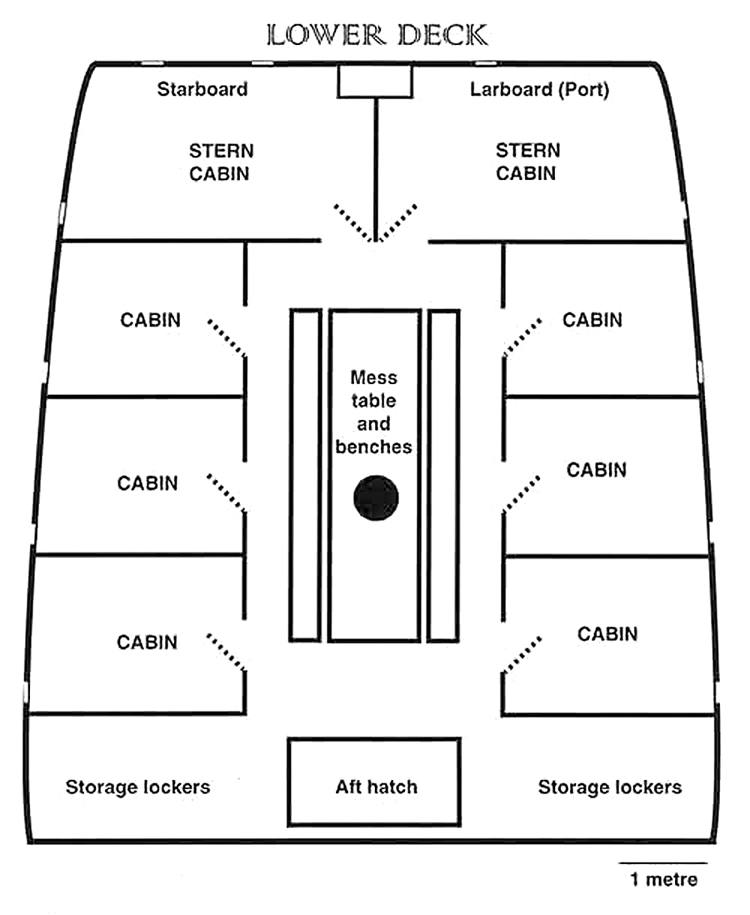


Keeping a large group of children amused and out of harm’s way on a long sea voyage was hard work for everyone. When the vessel was tacking across the wind, it was common for the slippery upper deck to be sloping at an angle of 45 degrees or more, so that even routine tasks such as lining up at the pantry for the handout of rations, or collecting boiling water from the galley stove, were fraught with danger. The boys had their own supervisor but the Society often provided nothing more than a slightly older youth, who acted more like a school prefect. The claustrophobic steerage was also a breeding ground for infections, all but guaranteeing that there would always be patients in the hospital beds.
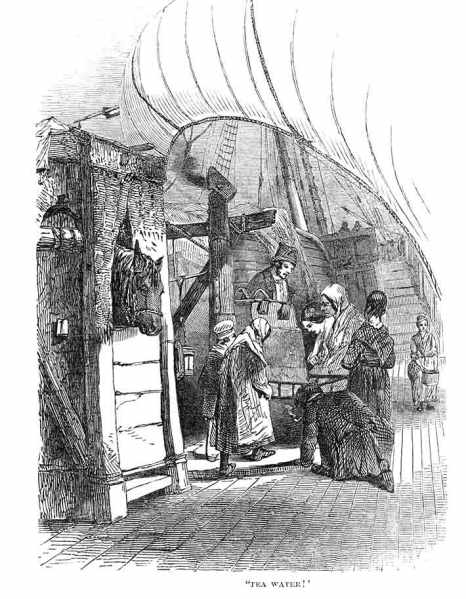
There were two types of ship’s boys on merchant ships. Some, like John, were part of the cabin and galley crew. He spent most of his working hours lurking around the cabins and the quarter galley stove. If he applied himself, he might be a steward one day. Ship’s boys hired as general trainees spent more of their time tarring and painting, or aloft in the rigging. In time, they would earn their place in the fo’c’s’le as able seamen. For this voyage, there was one such lad, John Sexton, and the apprentice steward would describe him many years later simply as ‘a boy like myself’.2 John was always vague about this other ship’s boy and they were neither close friends nor bitter enemies. If John ever knew his name – and he must have surely – he soon forgot it.
Thomas ‘Tom’ Prockter Ching and William Perry were the mates’ apprentices and John always referred to them as the ‘two little midshipmen’.3 Ching was the youngest son in a middle-class family in Launceston, Cornwall, Ching being a traditional Cornish name. His father, John Ching, was a wine dealer and apothecary (pharmacist) whose patented treatment for worms had secured the family’s fortunes.4 Tom was 21 years old and diligently studying his way towards becoming a chief mate and, eventually, a master. Perry was probably of a similar age and, like Ching, had joined the ship at London.
The barque had no designated cook. The steward, William Montgomery, prepared basic hot dishes for the first-class cuddy (dining room), but the crew and lower deck passengers got measured rations and had to prepare their own meals. Montgomery wore a white hat to keep sweat and stray hairs out of the cooking pots. It was the common symbol of a ship’s cook but he was also in charge of all dining arrangements and provisions. He carried on his person a pocket watch to anticipate the ringing of the ship’s bell, which signalled the change of watch. Stewards and their assistants often kept themselves apart from the fo’c’s’le, largely because their sleeping hours were different, and sometimes bunked down in the cabin pantry.
When the Charles Eaton crossed the equator, the crew dressed up in makeshift costumes for the usual ceremony of paying tribute to King Neptune. They rigged up a sail between the masts and filled it with water. Any sailor or male passenger deemed to be disrespectful to the king got tossed in, clothes and all.5 According to a descendant, the Hull family males were spared most of the rough stuff but the steerage boys joined in and loved it. It was a good time in the tropical heat for them to have a rough scrubbing down and head shave.
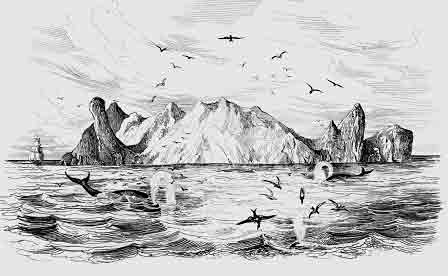
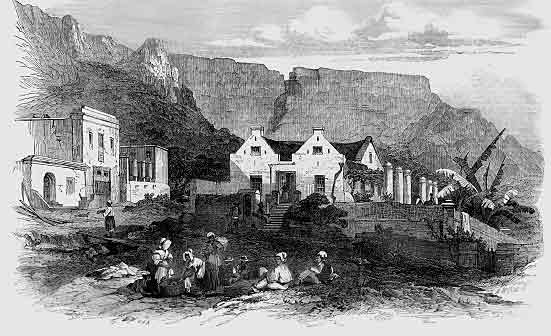
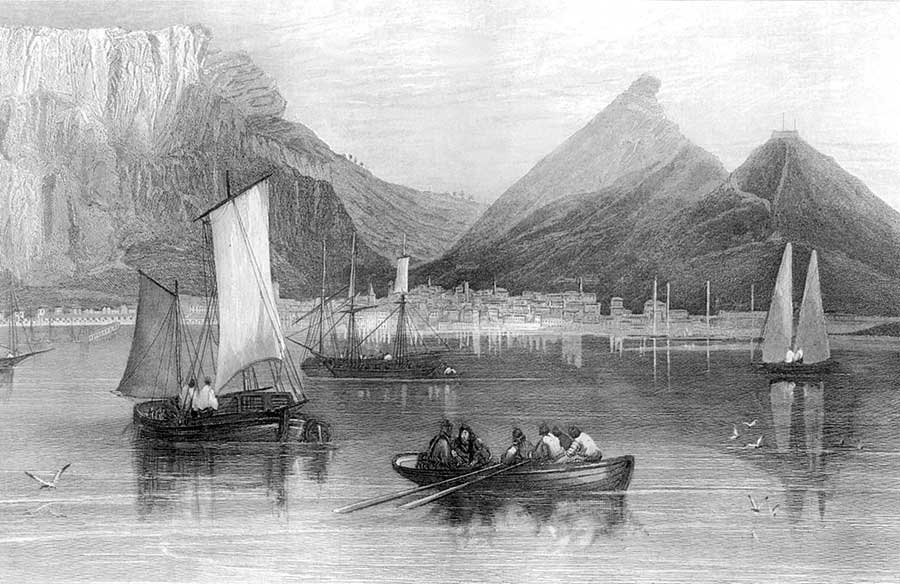
Once they had finally passed through the tropical calms, the sailors had to deal with the contrary trade winds. The time-honoured technique was to tack across the Atlantic towards the tiny island of Trinidade, about 700 miles ( 1125 kms) off the coast of South America, until they picked up the north-westerly trade winds, which carried them back across the Atlantic to Cape Town. This loop around the Atlantic added greatly to the length of the voyage but catching the trade winds usually shortened the sailing time.
Table Mountain when it finally appeared over the horizon in all its barren splendour was a distant but welcome landfall. Tapering away to the south were the majestic ridges and sandy beaches of the narrow peninsula known as the Cape of Good Hope, lush with wild grasses and cultivated crops, dissected by many streams. Its botanical gifts to the world included watermelon, cantaloupe and geranium. There had been a time when weary seafarers claimed for it no equal on Earth. It is hard to imagine a finer approach to a seaport.
Cape Town, with its population of about 25,000, was a novelty for English visitors. The houses looked like they had transplanted from Amsterdam. Most had flat tops and looked roofless when viewed from a distance. Signs of industry were everywhere, in the hurry-scurry of foot and hoof traffic along the streets and in the valleys cultivated with orchards, grain fields and vineyards. The farm workers, however, invariably proved to be slaves. On 1 May 1834, the Cape Town government approved the emancipation of all of the British Empire’s slaves, with the date for their freedom set at 1 December 1834.6 The Cape colonists were alarmed, predicting an acute labour shortage. One easy solution quickly taken up by them was the importation of English children as apprentices. Their impact would prove to be negligible, however, given that there were many more slaves waiting to be set free.7
On that same day, 1 May 1834, the Charles Eaton arrived at Cape Town with her cargo of 40 children and the Cape colonists eagerly snapped them up. They had all arrived safely and in good health. They had many years of labour before they would be free of their apprenticeships, although the girls did have the option of early escape from their bondage through marriage. Apart from the rules governing their punishment and a tiny annual wage, the apprenticeship terms in British colonies were similar to those for transported convicts. Most of the girls found work as domestic servants, while the boys got jobs as farm hands, servants or trade apprentices. Two lads became boat boys, while one lad ended up as a ship’s boy aboard HMS Trinculo, at anchor off Cape Town at the time.8
A few days later, on 10 May, a local Cape Town resident, John Thomas Buck, sent a letter to the churchwarden of St Luke’s parish in London, and it ended up being published in The Times (14 Aug. 1834). Speaking of the children already delivered to the Cape, Buck remarked: ‘the elder boys have not conducted themselves well, and given much dissatisfaction to their masters, and many of the younger ones have proved troublesome’. His letter triggered the widespread criticism of the exportation of pauper children to the colonies that would ultimately lead to the dismantling of the Children’s Friend Society.
There was a vessel moored in Table Bay that now becomes relevant to those still aboard the Charles Eaton. The Jane and Henry was a South-African-owned, 146-ton brigantine-schooner, recently arrived from Liverpool. As schooners go she was tiny and old, with no rating of any value. She was a sturdy vessel all the same, with more than a dozen long sea voyages to her credit.9 On a previous voyage in 1832–1833 the schooner had attracted notoriety when it was found that the master, Captain Robert Latimer, was criminally insane. He was sentenced at Cape Town to six months’ hard labour.10 Fortunately the schooner was now commanded by Thomas Cobern,11 a master mariner and resident of Cape Town. She was loading cargo for the Australian colonies and may have been chartered by a consortium of Cape businessmen. Her cargo consisted of Cape wine in ‘pipes’, which already had a small market in Australia, plus some general merchandise, including china, shawls and pickles. Having discharged her cargo, the Jane and Henry would return to Cape Town via Batavia (now Jakarta). For a time, the small schooner would follow the same route as the Charles Eaton.
From Cape Town, Moore headed south to Australia, going as far as he dared below latitude 40°. When, after a cold but uneventful passage, his crew moored their vessel at Hobart Town, Van Diemen’s Land, their arrival was greeted with more interest than they might have expected – but there was a reason. Most ships’ captains collected local newspapers along their route and passed them on to reporters at their next ports of call. On 28 March, having received November editions of the London papers from a passing ship, the Hobart Town Courier had confidently announced that ‘the ship Charles Eaton, 350 tons, Capt. Moore, . . . may be daily expected with goods from London for this port.’ By mid-April, none of the expected merchant ships had arrived. Unaware of the storms that had delayed their departure from England, the colonists began to fear the worst.12
When the Charles Eaton finally turned up in mid-June and anchored just off the town’s foreshore in Sullivan’s Cove, a reporter from the Courier sought a reason for the long passage from England. Moore explained that he had been held up in England by storms but refrained from mentioning the collision with another vessel that had caused much of the delay. He was soon busy signing bills of lading for additional cargo to Sydney, including five cases of hats and one case of bonnets from a local milliner.13 He also got two more cabin passengers, Mr and Mrs Severin Kanute Salting, who had travelled from the London Docks aboard the brig Meanwell. Moore had a variety of consigned cargo for the port, including barrels of salted meat and fish for a ship’s chandler. He soon discovered, however, that Hobart Town was going through a brief economic downturn and was not particularly receptive to speculative cargo. He managed to sell some alcohol and the usual popular food items such as raisins and treacle for ships’ puddings, but not much else. The Jane and Henry’s captain had little luck in Hobart Town either, and soon sailed for Sydney. Moore did, however, have one more visitor. Captain Thomas D’Oyly of the Bengal Artillery was seeking passages to Sourabaya for himself, his family and his Hindu servant. The D’Oylys have left behind a detailed account of their lives, and the chain of events that brought them to that fateful moment. Many of the personalities introduced in the following chapter will re-emerge later to make their contributions to the wake for the voyage of the barque Charles Eaton.
Some images of Hobart Town in the 1830s
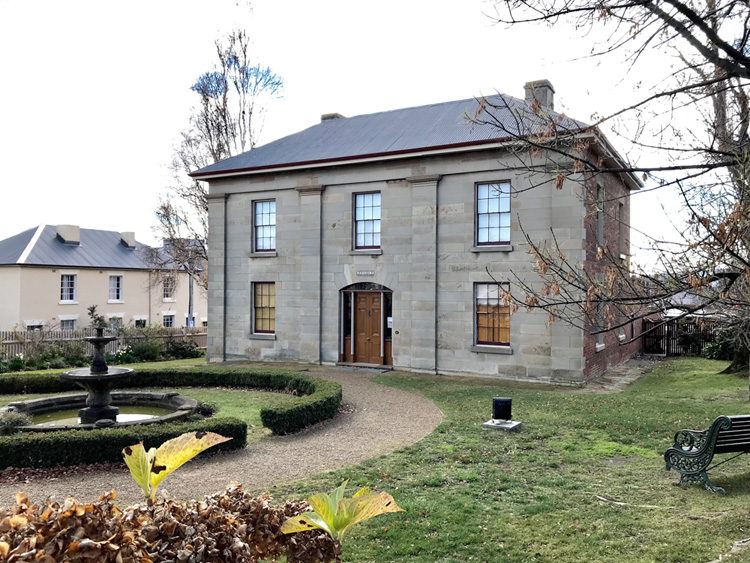


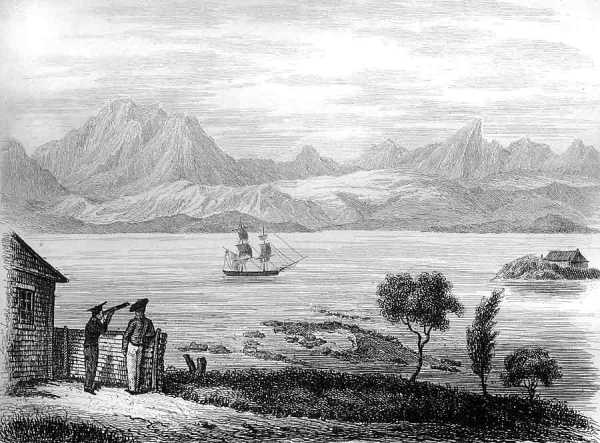
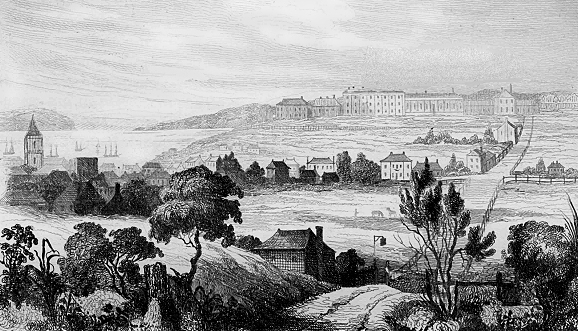
Except where stated, illustrations are reproduced from M. Dumont D’Urville, Voyage Pittoresque autour du Monde, vol. II. Paris: Furne et Cie, Libraires-Editeurs, 1839. The artist is M. de Sainson.
Notes to Chapter 2
- Sydney Monitor, 11 Nov. 1836.
- Ireland’s London deposition, The Times, 31 Aug. 1837.
- William Bayley file, copy of statement by Captain Igglesden, Tigris, 31 July 1836, Dixson Library, State Library of New South Wales, Sydney, A1074. His use of the word ‘midshipmen’ suggests that in common sailor’s parlance it was not a term restricted to apprentice officers in the navy.
- See Laurence Green, A Hollow Sea: Thomas Prockter Ching and the barque ‘Charles Eaton’, Ashprington, Devon: RGY Publishing, 2007, for biographical information about Ching’s family.
- Email from D. Morris, a descendant of the Hull family, to the author.
- John Fisher, The Afrikaners, London: Cassell, 1969, pp. 58, 99.
- Lacour-Gayet, Robert, A History of South Africa, Stephen Hardman (trans.), London: Cassell, 1977, p. 71.
- Geoff Blackburn, The Children’s Friend Society: Juvenile Emigrants to Western Australia, South Africa and Canada, 1834–1842, Northbridge, Western Australia: Access Press, 1993, pp. 170–71.
- Lloyd’s Register of British and International Shipping, 1834, microfiche.
- Hobart Town Courier, 23 Aug. 1833. The story of what happened on board the Jane and Henry on her voyage to Van Diemen’s Land (Tasmania) in 1832 is interesting example of shocking exploitation of pauper emigrants by a ruthless operator, with the additional hazard of a master and a chief mate who were psychopaths. Captain Larimer had been released from prison just prior to departure from Liverpool and was later described in contemporary accounts as criminally insane. The brigadine was confiscated by the Cape Town government to pay off debts and resold in time for the 1834 voyage to Australia.
- This spelling of Cobern’s name has been taken from Cape Town’s 1833 census. Other spellings include Cobairn and Coburn.
- ‘Domestic Intelligence’, Hobart Town Magazine, vol. III, no. 14, April 1834.
- Sydney Herald, Supplement, 21 July 1834.
Chapter 3: the D’Oylys of India
Just outside the village of Kirby Wiske, near the town of Thirsk in Yorkshire, there once stood a very old stone-built house, called Sion Hill. The estate and all its structures fell into disrepair until Mr Edward D’Oyly bought it in 1799.
Captain Tom D’Oyly of the Bengal Artillery, briefly introduced at Hobart Town in the previous chapter, was Edward’s son. Born with his twin brother, Edward Jnr, in 1794, he moved with his parents to Sion Hill in 1800. Edward D’Oyly and his wife, Hannah, spared no expense in renovating the hall and adding new wings, landscaping the grounds with gardens leading down to the River Swale. In time Sion Hill was reborn as one of the most attractive estates in North Riding, and its owners were considered by all to be ‘one of the happiest and most united of families’.1
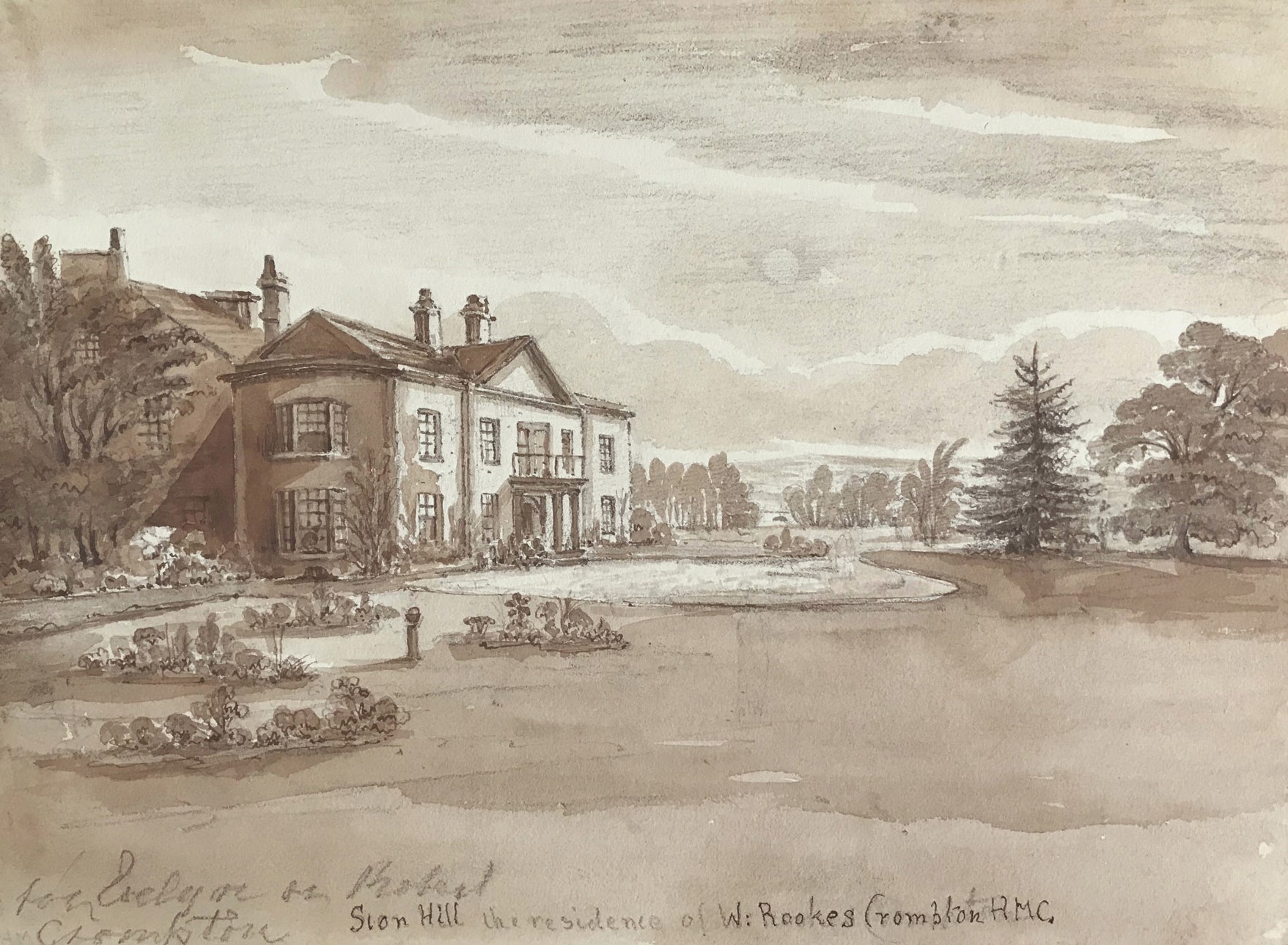
The D’Oylys relished their life at Kirby Wiske for a number of years. Financially, however, they were struggling. In June 1808, D’Oyly placed a single modest advertisement in the York Herald offering the Sion Hill estate for sale but did not repeat it. This was followed soon after by run of family and financial tragedies. Edward Jnr wanted to become a mariner, so his father bought a large share of the huge chartered East Indiaman, Jane Duchess of Gordon, which had previously belonged to her master, Captain Cameron.2 The captain then obliged them by employing Tom’s 11-year-old twin brother as a midshipman.
In March 1809, a convoy consisting of 15 East Indiamen and one brig-of-war was caught in a fierce hurricane south of the island of Mauritius that lasted for three days. Five of the ships, including the Jane Duchess of Gordon, sank with the loss of all lives.3 Edward was 13 when he perished. At about the same time, his older brother, James, died of a fever while still a cadet at Calcutta (now Kolkata) in India. Captain Cameron’s widow and 11-year-old daughter, Anne Cameron, visited Sion Hill when they heard the news. They found the family in a terrible state. Not only were they still mourning the deaths of James and Edward, but an ailing infant son, Josephus, would die within days.4 Edward and Hannah were hospitable to the captain’s widow and Anne Cameron exchanged letters with the eldest daughter, Elizabeth, for a time. Twenty-eight years later, Anne Slade (née Cameron) re-emerged to play an important role in the D’Oyly family’s history.5
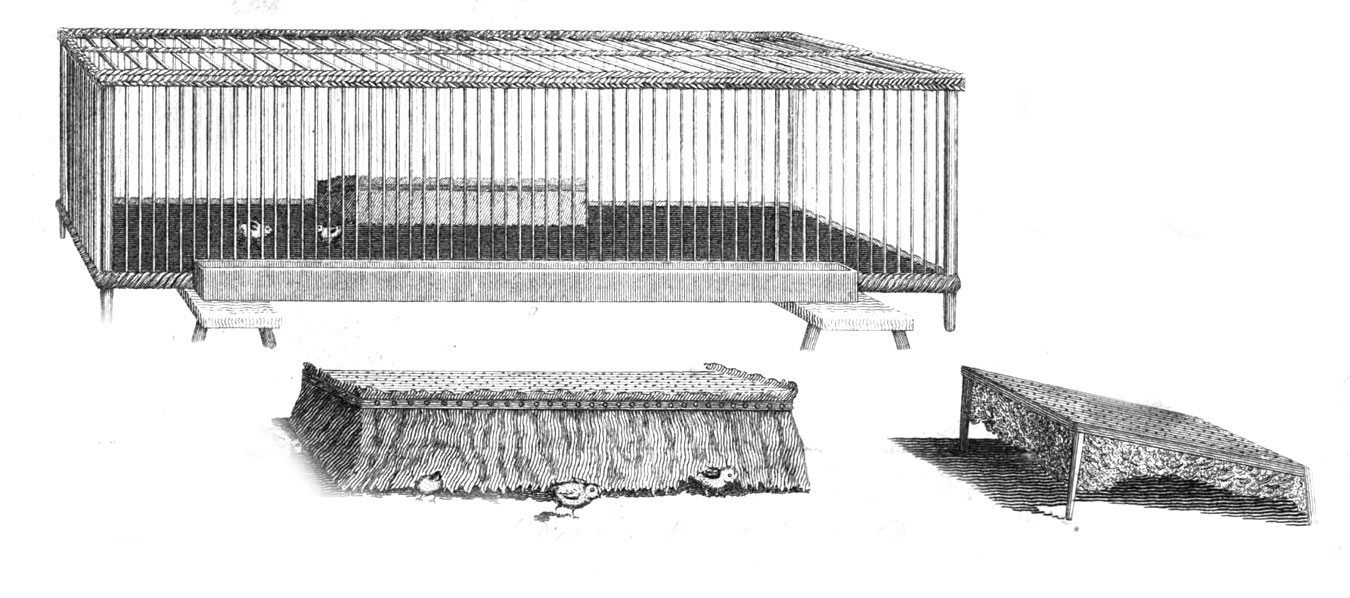
Edward and Hannah, with their dream of being ship owners now extinguished, had insufficient income from their estate. To their credit, they tried many ways to expand it. In 1808 Hannah, who was quite inventive, had set up a chicken farm and sold eggs and chickens to the local markets. She had a large stock of hens and roosters and came up with a new way to raise chickens that earned her a prestigious science award. She envisioned a future in which chickens could be commercially raised anywhere, including in city backyards, in cages with an artificial ‘mother’ hen. With a high survival rate, these healthy chickens would become free-ranging egg layers but also the cheaper meat of choice at the markets. Hannah D’Oyly was a woman ahead of her time. She was also one of the first people in England to commercially cultivate bull-rushes (on the Sion Hill estate) for the rush seats market. Estate workers had shored up the banks of the River Wiske with soil and willow trees to prevent flooding and the numerous holes they dug became artificial ponds, ideal for bull-rush cultivation.
Her husband, for his part, turned one of the farm sheds into a large machinery workshop well stocked with an array of tools. He had a gift for repairing his own machines and it wasn’t long before local farmers began bringing their broken machinery to him for repair. Hannah dispensed Christian charity but was also business oriented. Edward, however, was very sociable and well liked, and didn’t charge for his labour. He also generously employed far more local labourers than his estate could afford.
To the great chagrin of his children, Edward D’Oyly was broke.6 His solution was to asset strip and re-mortgage, until there were very few assets left. The begging letters that he wrote to his bank at that time make distressing reading. By 1815 he was too afraid to attend the Thirsk market for fear of running into one of his creditors. Tom, their oldest surviving son, escaped from the deepening misery at Sion Hill when he joined the Bengal Army in 1810, and was among the first intake of students at the EIC’s Addiscombe College near London.
Two years later, in 1812, he was posted to Bengal as a subaltern/fireman in the artillery.7 A relative, Sir John Hadley D’Oyly, the EIC’s Controller at Calcutta, and later his son, the enthusiastic amateur artist Sir Charles D’Oyly, took an interest in Tom’s career and promoted his merits in every quarter, introducing him into the highest echelons of Calcutta’s society. During his first year in Bengal as a ‘griffin’ or greenhorn, Tom lodged for a time with the baronet. He was the second ‘griffin’ to experience the hospitality of the baronet’s household, for his older brother, James, also enjoyed that welcome while a cadet in the Bengal Infantry. James joined his wealthy relative’s circle for a spot of hog hunting and died soon after from a fever thought to have been caused by an infected wound. Sir Charles would subsequently publish the illustrated burlesque poem Tom Raw the Griffin, which records some of the shared experiences of griffins like his two relatively distant and impoverished cousins.
In 1817, Lieut Tom D’Oyly finally took part in one brief battle and ended up in a safe staff position. Apart from that, he passed an uneventful eight years in Bengal until Charlotte Williams arrived on the scene.
Charlotte was the daughter of Henry Williams, for many years the Company’s commercial resident at the Commercolly (now Kumarkhali) station.8 In those days it was a river village in the low-lying and often flood-soaked region known as the Ganges delta.9 Today it is a major city in Bangladesh. Henry and his wife, Agnes, had two daughters, Charlotte (1796) and Fanny (Frances Sophia 1798).10 By 1800 they had parted acrimoniously amid claims that Agnes had been unfaithful, and the two girls lived at Russell Square in London with their wealthy grandparents. Charlotte’s grandfather, ship captain Stephen Williams, was a director of the EIC (1791–1804), while his wife, also Charlotte and sister of Sir John Hadley D’Oyly, was a former nurse to the two youngest of the 15 children of King George III, Prince Alfred (died aged two from a smallpox inoculation) and Princess Amelia.11
When Mrs Williams finally left the royal household, she maintained her ties with the royal family. Her brother-in-law, the wealthy banker and MP, Robert Williams, of Bridehead in Dorset, owned a fleet of East Indiamen and the family named one of them the Princess Amelia.12
King George III and Queen Charlotte were possessive parents and their six daughters did very little socialising outside their own households.13 Princess Mary, the Duchess of Gloucester, was their third daughter and she doted on children, making it inevitable perhaps that she became young Charlotte’s favourite royal. The impressionable little girl grew to womanhood treating Princess Mary as a much-loved friend. The princesses were often delightful companions but they could also be demanding and thoughtless. Given their royal status, it was only to be expected. The same traits in Charlotte were less easy to accept. There is no detailed description of Charlotte but there is a small bonus in knowing that her hair was brown-gold or auburn. In later years she would braid and/or twist it up into a coiffure with combs.14
In 1818, Henry Williams returned to England on leave and escorted his two daughters back to India. Their second cousin, Sir Charles D’Oyly, now the seventh baronet following the death of his father, was one of the Company’s opium agents, and he organised a ball at his palatial Calcutta home to introduce the two Williams girls to society. His other relative, Lieut Tom D’Oyly of the Bengal Artillery, was also a guest. Charlotte found Tom’s charms irresistible and their marriage, on 10 May 1820, united two branches of the D’Oyly family.
Tom was based at the Dum Dum artillery station, on an extensive plain four miles (seven kilometres) north of Calcutta. Married officers lived in spacious bungalows around a small drill ground, but Tom and Charlotte bought their own more substantial bungalow, at Dum Dum but off the station.15 Children, when they began to arrive, were welcome distractions. Their first son, Thomas (Tom Jnr) was born in October 1821, followed by Edward in 1823 and George three years later.16
The D’Oylys weren’t wealthy so it’s likely that they borrowed money from a rich Indian money-lender to buy their large off-station bungalow. In status-conscious British colonial Calcutta it was all about keeping up appearances and many a young British officer ended up in financial straits when he couldn’t meet the interest on his loan. Tom, as main heir, expected something from his late father’s will. He got his share of the Sion Hill estate all right, but once it was sold and the multiple mortgages paid off there wasn’t a great deal of it left. Fortunately Charlotte had received a handsome inheritance when her grandmother died in 1813.
Both the real Lieut Tom D’Oyly and the fictional Lieut Tom Raw in Tom Raw the Griffin had scolding wives called Charlotte and in 1824, when the book was being written, they both had two sons, the oldest of whom was also called Tom. Each then had another son. The poem makes it clear that the baronet had little time for army wives. But Charlotte, who had always been proud of her relative’s achievements, may have been both puzzled and hurt by his satire. She may even have scolded Sir Charles or expressed her dismay. If so, then it had the desired effect. For the rest of his life Sir Charles did not publicly acknowledge any involvement with Tom Raw the Griffin. The book’s illustrations in particular attracted a lot of praise so it was quite a sacrifice on his part.
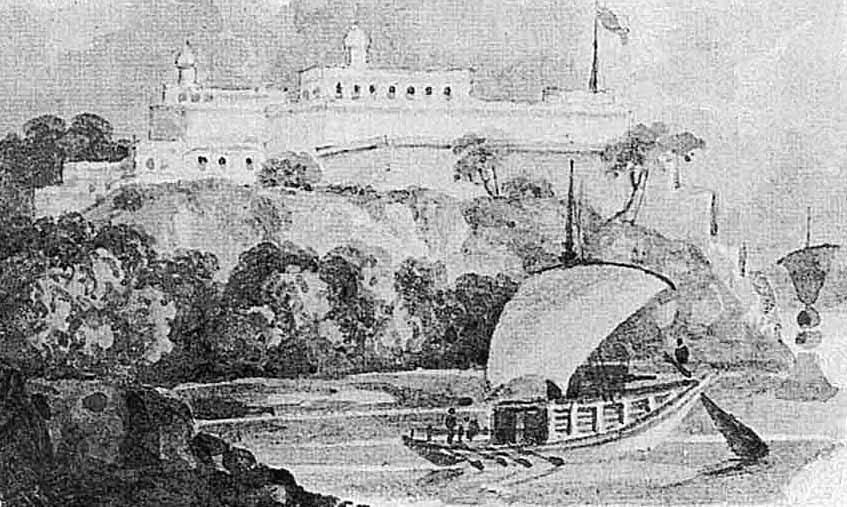
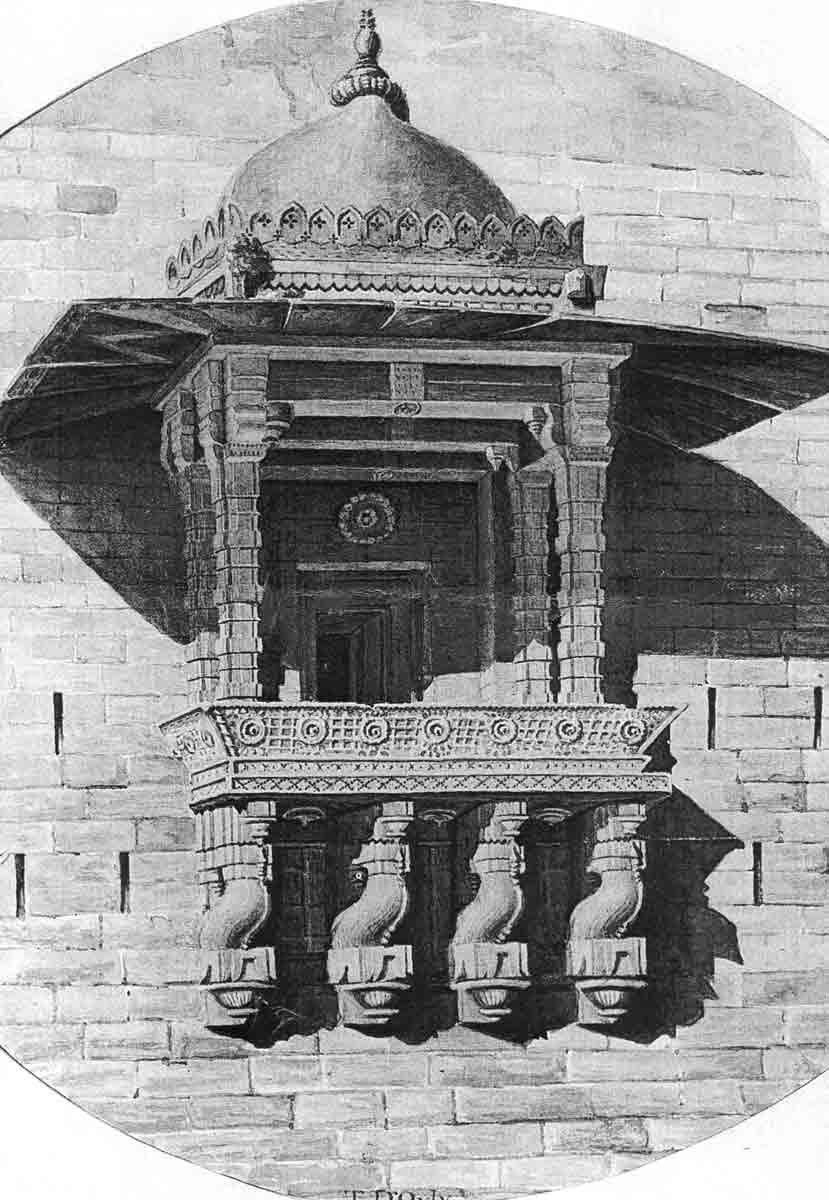
Tom’s oldest sister, Elizabeth, had married a conveyancing solicitor, William Bayley, of Stockton-on-Tees in Durham.17 When Tom faced the usual dilemma of sending his two eldest sons to England for their education, the Bayleys agreed to take them. Those leisurely years in Calcutta were ending, however, for Tom got a promotion to Captain and a posting to the Company’s ordnance at the Chunar Fortress, in the Mirzapoor district of northern Bengal. The promotion came at a price. Chunar had a reputation for being one of the hottest British stations in India.18 It is on the southern bank of the River Ganges, about 17 miles (28 km) southwest of the holiest Hindu city of Benares (now Varanasi).
During the D’Oylys’ time, there were about 1000 invalids19 stationed at Chunar. It was the Company’s invalid station, where they herded their chronically sick and wounded British soldiers, together with their families. They guarded an ancient and decaying fort that no one attacked. Some of the soldiers were old but most were young, victims of India’s cholera epidemics. Officers, however, enjoyed ‘the usual East Indian splendour’20 at Chunar, by which we can assume that they actually lived in an airy bungalow shaded by trees. Many of the officers stationed at Chunar were also invalids. Captain D’Oyly may have been unwell for some time. Additionally though, Chunar attracted a generous remote-station allowance, and he needed the money.
In August 1831 Charlotte gave birth to their last child, a son called William, preceded by the death of an infant daughter in 1829.21 When Charlotte fell pregnant with William, having already lost a daughter, she returned to her Calcutta bungalow for her confinement and William’s birth and refused to return to Chunar. A few months later, the D’Oylys received the news that Tom’s oldest sister, Elizabeth Bayley, had died suddenly at Stockton-on-Tees on New Year’s Day, leaving her husband to raise their five children alone, including a newborn son.22 William Bayley was now the sole guardian of their two eldest boys. Despite their brother-in-law’s reassurances, it must have occurred to them that this was an unreasonable burden.
The following year, Tom applied for overseas sick leave, on the basis that his health had suffered under Chunar’s heat. He was also running out of time. Every one of the Company’s officers and civil servants in India was entitled to two years of fully paid sick leave – and they invariably used their benefit. Tom’s choice of destination for his leave should have been obvious: go home to England and Tom Jnr and Edward, now aged 12 and 10. Yet he nominated Hobart Town in Van Diemen’s Land instead. It was an Australian penal colony but it had a mild climate, making it a favourite destination for invalids from India. Charlotte, who was ‘pining to be restored to her absent Children’23 shed many tears of disappointment. At the same time, the arrangement Tom and Charlotte had with William Bayley was very convenient for them. Bengal Army officers aimed to retire back to England on at least the full pension of a major, a goal they could only achieve after 25 years of service in India. If they retired early, they received a half-pension instead. Captain D’Oyly needed one more promotion and three more years in India and they would be financially set for life.
The family left Calcutta on 21 March 1833 with a ship’s hold stacked with furniture, plus crates and trunks of household goods. They disembarked at Port Louis on Mauritius for what would prove to be an extended sojourn. They posted their en-route letters to their sons from this port. The first ship to come along bound for Van Diemen’s Land was the Indiana, out of London. Her master, Captain Webster, had detoured to Mauritius to pick up a cargo of sugar. On 9 September 1833, the Indiana took on board a pilot for the final navigation up the Derwent River. Hobart Town (now the city of Hobart) when it finally came into view proved to be a charming replica of an English town. It was spring when they arrived and flowers were blooming under a soft southern sun. Within a week of their arrival, they not only had three assigned convict servants, they had already settled into a large, recently vacated, house in the little town of New Norfolk.24 Rental properties were difficult to come by in New Norfolk, particularly at short notice. Captain D’Oyly may have had, through their Calcutta lawyer, a local contact, a landowner called Richard Armstrong.25
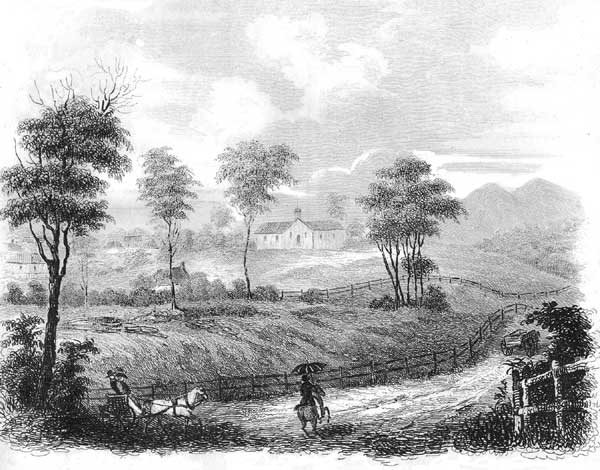
New Norfolk is about 22 miles (35 kms) north-west of Hobart along what was, in 1833, an uncomfortably rough road. In those days it was flattering to its inhabitants to call the tiny settlement a town, since it consisted of little more than a handful of cottages scattered haphazardly around a church, a school, a hospital and a few fine houses and inns. For India invalids, however, it was ideal. It was an enchanting village with a moderate climate. It also had an excellent invalid hospital for settlers and convicts that dealt at that time with both physically and mentally ill patients. It was a long way from Calcutta to New Norfolk. Despite its curative qualities, only the most seriously ill India invalids bothered to make the effort to get there.
India invalids suffered from respiratory complaints often exacerbated by smoking the hookah pipe, and liver complaints caused by drinking too much alcohol in the sub-continent’s sapping heat. More seriously, bouts of cholera and chronic diarrhea had destroyed their health. They often moped and left it up to their spouses or friends to make the necessary decisions. Many of them wanted to return to England but their surgeons advised against it. The dramatic change of climate would have an adverse affect on their damaged lungs. Sick leave in England too often proved fatal. The East India Company’s own surgeons recommended the Australian penal colonies instead.26
Charlotte must have endorsed the decision to go to New Norfolk. Her husband had been a prolific letter writer to his friends and relatives in England, tiring them no doubt with copious details of his lifestyle in India. His pen was now still. It was left to his wife to exchange letters with William Bayley and their sons in England.
It does appear, though, that Charlotte was not completely forthcoming in her letters to her benefactor, William Bayley. The wage of an artillery captain in the Bengal Army was modest, yet the lifestyle the D’Oylys created for themselves in Van Diemen’s Land was extravagant for holidaymakers. The virtual bankruptcy of his parents at the Sion Hill manor in North Riding, Yorkshire, had made Tom frugal with his money. No one made that claim about Charlotte, who relished the lifestyle of a British memsahib in colonial Calcutta and was happy to duplicate it at New Norfolk. She had also inherited a large sum of money from her grandmother, Mrs Charlotte Williams, and was probably keen to secure a future for her four sons in one of the British colonies.
Theirs is not just the story of a family holiday in the backwoods of Van Diemen’s Land, with smoking wood fires and leisurely walks while Captain D’Oyly recuperated, although that was certainly a part of it. Was Bayley told, for example, that Tom and Charlotte had initiated the purchase of almost four acres of land on Warwick Street, in the centre of Hobart Town, previously owned by a carpenter called Montgomerie and already planted with fruit trees? Perhaps they intended to return and settle in the penal colony or perhaps it was a wise investment. Hobart Town’s reputation was growing and land values in the township were expected to skyrocket . Unlike officers in Britain’s own armed forces, Bengal Army officers were seen as mercenaries employed by a private company and had never been eligible for free land grants in Britain’s Australian colonies.
The house and grounds that the D’Oylys rented at New Norfolk must have been vacated by tenants or owners who were leaving the colony. Tom and Charlotte probably bulk bought almost everything the previous occupants couldn’t take with them, including farm animals and equipment. To this they added many precious and exotic possessions they had brought with them from India, with the expectation of entertaining in lavish style. By mid-May 1834, however, the captain was preparing for his own return to Calcutta. He handed all of their goods and chattels over to the local auctioneer, John Stracey, who placed the following lengthy and overly descriptive advertisement in his free and short-lived newspaper, the Trumpeter General, 27 May 1834:
“On Wednesday, the 18th June, and following days, commencing at 12 o clock, on the Premises, at New Norfolk, without reserve, MR. STRACEY, WILL SELL BY PUBLIC AUCTION, ALL the Valuable furniture, musical instruments, books, horses, carriages, plated goods, live stock, &c. &c., the property of Captain D’Oyly, who is about to return to India—comprising very handsome European made dining tables, 17 feet by 5, forming, if required, several convenient tables, very handsome dining room chairs, mahogany Cleopatra couch on casters, with mattress and pillows, mahogany footstools,, iron wood tea trays, hearth rugs and carpets of the most costly description, English and Indian manufactured mahogany bagatelle board, with mace, cue, and balls, an elegant backgammon box, with dice and men complete, a remarkably handsome and curious set of ivory men, breakfast, loo, drawing room, hall, lamp, camp, and bedroom tables, drawing room chairs, one pair of very splendid China jars, liquor case with cut bottles and plated stands neat tea and medicine chests, teak wood cheese stand, a superb ladies dressing case, fitted up with scent bottles, jug, basin, brush, trays, &c., with several drawers, compartments, and conveniences, large and handsome teak wood bedsteads, teak wood drawers, wardrobes, and clothes cupboards ; the whole of the bedding is the best that could be purchased. Fenders, fire irons, and fire guards, kitchen utensils all, nearly new. The China ware is of a beautiful and elegant pattern ; the cut glass desert [sic] service is splendid and costly in the extreme ; the dinner service is one of Spode’s best; the fowling pieces and rifles are in cases nearly new, by the first makers, and complete, with apparatus ; a set of Golf clubs are very rare ; the plated goods, candlesticks, and lamps, have been but little used; the piano-forte is by one of the first makers; the Stanhope is very handsome, built by Barton and Co, of London, with hood, lamps, and patent axle, colour, straw picked out black, has spare linings, boxes, caps, nuts, and new wheels; the phaeton has been little used and turns remarkably light ; the harness corresponds in neatness and quality with the carriages ; the saddles, bridles, and martingales are nearly new; the horses, pigs, poultry, bullocks, and husbandry implements need no comment till the time of Sale; the stock of wine is really superior and rare, and the porter will be found very good. The miscellaneous articles will comprise about two hundred lots, and are all very useful. The library contains many standard curious and valuable works elegantly bound. It can so very seldom happen in this part of the world, that an Auctioneer has the gratification to offer the public property of so truly valuable a description as Captain D’Oyley’s [sic], that comment upon its first cost, its elegance combined at once with the strictest regard to comfort, and the great care which has been taken of it might only tend to throw a doubt upon its great value ; suffice it therefore to say, that to those who may not wish to purchase, it will be a great treat even to take the opportunity of getting a sight of eastern magnificence at the time of sale, which will commence daily at 12 o’clock. The mode of payment will be cash for all purchasers under 25l. That sum and upwards, bills with two names, at three months.“
Phew! Clearly the family hadn’t been roughing it in Van Diemen’s Land. They were certainly leaving behind in the colony a lot of unfinished business. Eight months after their arrival, the Caledonia had arrived from Calcutta, with a letter for them containing the news that Captain D’Oyly had been promoted to a more senior position.27 With his health now seemingly restored, he was anxious to get back to work. Misfortune was on his side, for the barque Charles Eaton had also just arrived and she was bound for Calcutta via Sourabaya and Canton.
Anyone who did business with the D’Oylys at that time would have assumed they intended to settle permanently at New Norfolk and Hobart Town. Yet they abruptly auctioned all of their recent purchases, along with everything they had brought with them, and rushed to sail away upon the first ship heading in the general direction of Calcutta.
D’Oyly had just been informed of a duty promotion that would presumably have allowed him to buy a seniority promotion from captain to major. This had long been his aspiration and he was anxious to get back to Bengal before the post was offered to someone else. As yet, he had not formally resigned from his position with the EIC.
Charlotte wasn’t convinced that going back to India was necessarily the right thing to do. She would later admit to her brother-in-law, William Bayley, that a full retirement pension was their preferred retirement strategy but her husband’s health took precedence over financial considerations. She was already considering the possibility that Tom’s ill health might return in India’s oppressive heat. With her additional desire to be reunited with her two oldest boys, coupled with an equally strong wish to be back with her numerous relatives in Calcutta’s colonial splendour, she was conflicted and often tearful.
The letter from India may have forewarned them that the full annual pension the EIC offered to their military and civilian employees after they had completed 25 years of service in India would soon be available after only 23 years of service. D’Oyly had only to remain with the EIC in India for another eighteen months and if he played the right cards he would be eligible for retirement on the full annual pension of a major. Remaining in Van Diemen’s land would have meant a half-pension based on a captain’s salary. It was a big difference in retirement income.

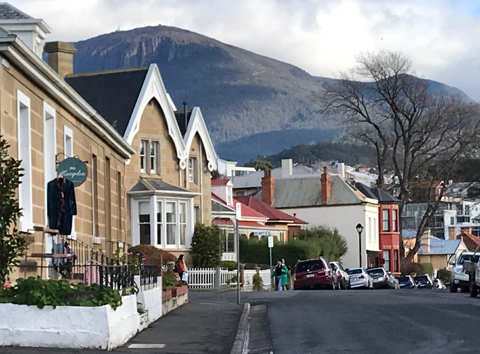
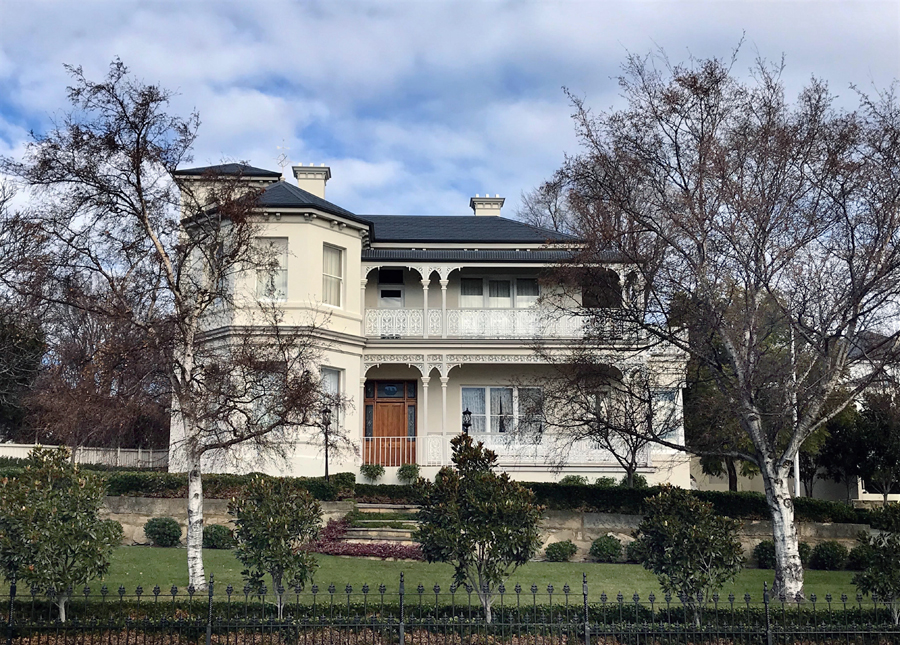
The lavish life of ‘eastern magnificence’ enjoyed by the D’Oylys in India has been part captured in these hastily executed little juvenile sketches. They have little or no value and are not well cared for, but they do reflect the lifestyles of the D’Oyly clan in Calcutta. The clothing dates the time-frame of the sketches to late-eighteen, early-nineteenth century. They are separate pages from a sketch book reportedly sold by Sotherby’s in 1992, and were attributed at the auction to ‘Sir John D’Oyle’, who never lived in India. He was on the Board of Directors for the East India Company for a time and would have had access perhaps to ex-colonists with India memorabilia. The sketchbook contained about 45 sketches, which were subsequently sold individually. They attempt to capture or recreate a bygone era with the simplicity of amateur photo snaps, and they are charming. I’m just grateful that someone bothered to take the time to paint them. They have been kept out of the sunlight and there appears to be very little fading. The better sketches are attributed to Sir Charles D’Oyly, the 7th baronet, and some of the cruder sketches perhaps to his younger brother, Sir John D’Oyly, the 8th baronet.
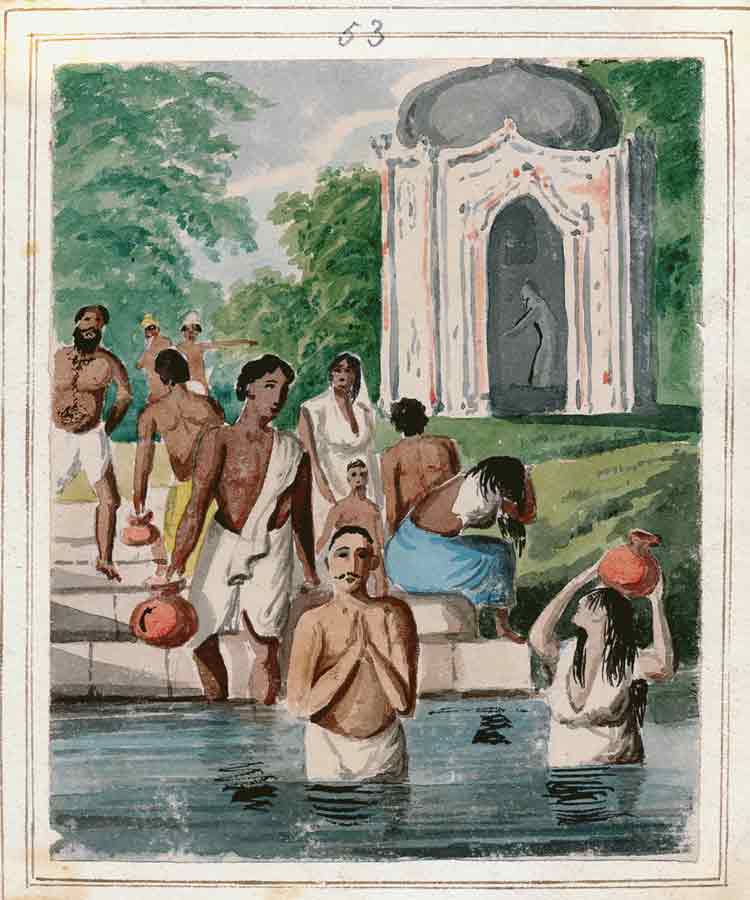
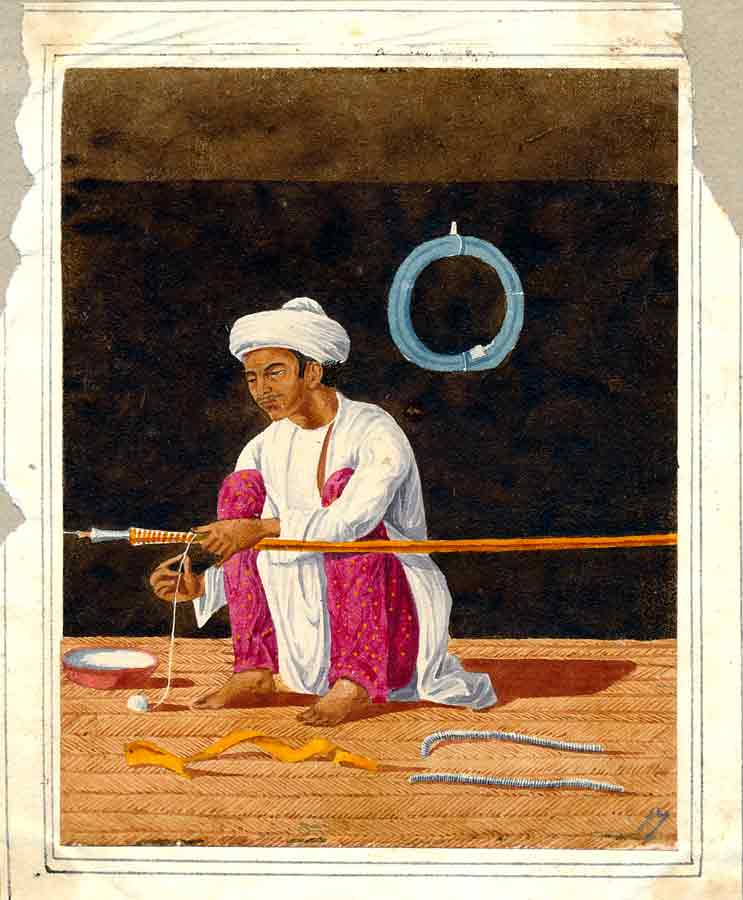


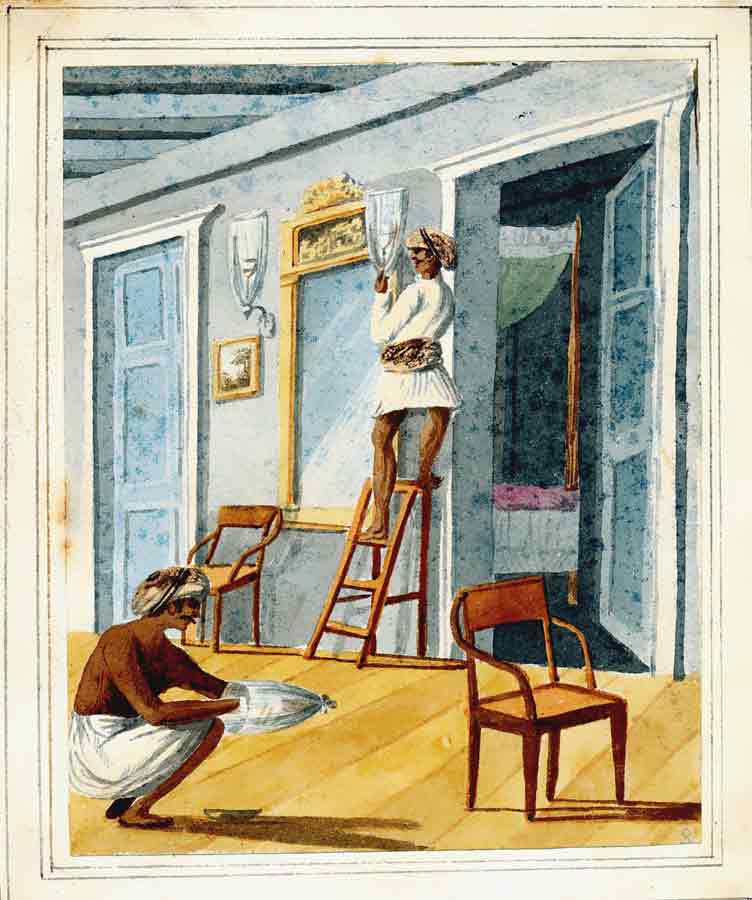

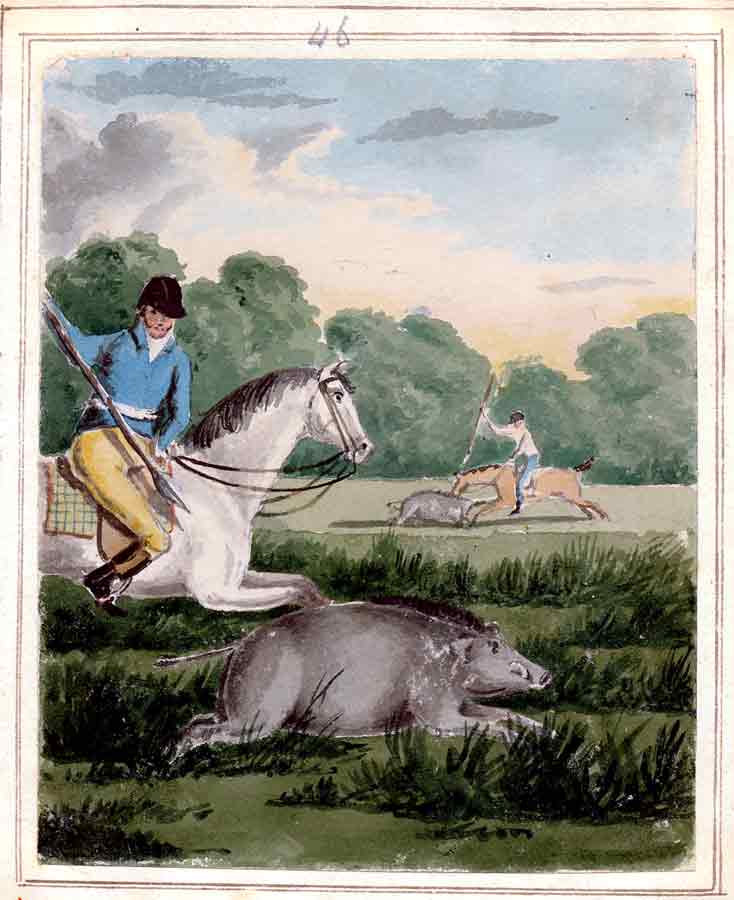








…
..
…
Notes to Chapter 3
- William D’Oyly Bayley, A Biographical, Genealogical and Heraldic Account of the House of D’Oyly, London: D’Oyly Bayley, 1845, p. 148. Much of the information in this chapter has been taken from D’Oyly Bayley, pp. 131−55.
- The ship’s largest shareholder was Charles Christie. D’Oyly, however, was a substantial part-owner.
- The North American Review, 1844, p. 342.
- The D’Oylys lost five children in a little over one year, including a stillborn daughter and another son who collapsed and died on his way home from school.
- William Bayley file, letter from Slade to D’Oyly family, 14 Nov. 1836, Dixon Library, State Library of New South Wales, A1074.
- Sion Hill was remortgaged in part to Mr William Bayley, of Northallerton. His son, also William Bayley, a solicitor in Stockton, married Edward and Hannah’s oldest daughter, Elizabeth. Private correspondence of Edward D’Oyly, in the possession of the author, dated 1815. The hall continued to exist for more than 100 years before being demolished for an architecturally superior new manor.
- For details on Captain Thomas D’Oyly, see Hodson, V. C. P., List of Officers of the Bengal Army, London, 1927–47, vol. ii, pp. 83–84; IGI; India Office Records L/MIL/10/23, ff. 171–72.
- East India Register and Directory, London: East India Office, 1818 and post.
- Edward Thornton, A Gazetteer of the Territories under the Government of the East India Company . . . 4 vols, London: W.M. H. Allen & Co., 1854, vol. 2 p. 10 and vol. 3 pp. 178–79. Also known then as Commercholly, Comercolly and more recently as Kumerkhali, it is now in Bangladesh, on the Ganges river north of Dhaka. Pubna is now called Pabna. Henry Williams was employed in the Company’s service from 1792–1833.
- See the will of Mrs Charlotte Williams, dated 1811, held by the National Archives UK. Mrs Agnes Williams, in a letter c. 1845, supplied the family genealogist, D’Oyly-Bayley, with their birth years. According to IGI the girls were born at the Williams ancestral home in Winterbourne Herringston, Dorset.
- The occupation as a writer/clerk in India was reserved for close relatives of EIC owners and directors. Mrs Williams (née Burrington) does not appear to have played a prominent role in her daughters’ lives. In those days, when a couple separated the father automatically under law had first claim to any children.
- Charles Hardy, revised by Horatio Charles Hardy, A Register of Ships, Employed in the service of the Honorable the United East India Company, from the Year 1760 to 1810 . . . , London: Black, Parry, and Kingsbury, 1811, p. 120.
- For information about Princess Mary, see Flora Fraser, Princesses: The Six Daughters of King George III, New York: Anchor, 2006.
- A comb thought to have belonged to Charlotte was later found on an island called Aureed.
- Ultimately inherited by their second son, Edward Armstrong Currie D’Oyly until his death in 1857.
- William D’Oyly Bayley, A Biographical, Historical, Genealogical, and Heraldic Account of the House of D’Oyly, London, 1845, pp. 131–55.
- Married 27 May 1819, at Northalleton, Yorkshire. Source: IGI. (William D’Oyly Bayley was their eldest son).
- Walter Hamilton, ‘Chunar’, East India Gazetteer 1825, London: W. H. Allen, 1828, p. 284.
- Right Rev. Reginald Heber D.D., Narrative of a Journey through the Upper Provinces of India from Calcutta to Bombay, 1824–1825 (with Notes upon Ceylon,) : An account of a journey to Madras and the Southern Provinces, 1826, and letters written in India, vol. 1. London: John Murray, 1843. Section on Chunar, Chapter XIII, pp. 401–13.
- D’Oyly-Bayley, p. 155.
- Losty, J. P., ‘A Princess’s Memento’, South-Asian Studies, no, 7, 1991, pp. 75–82.
- IGI.
- William Bayley file, Charlotte D’Oyly to Bayley, 20 July 1834, Dixon Library, State Library of New South Wales, A1074.
- Hobart Town Courier, 20 Sept. 1833.
- Hobart Town Courier, 12 July 1838.The newspaper advertisement, placed by Armstrong on behalf of the Calcutta lawyer tasked with finalising Captain Tom D’Oyly’s affairs, does suggest that the D’Oylys were checking out the colony with their forthcoming retirement in mind.
- For a description of the complaints suffered by India invalids, see James Johnson, M.D., An Essay on Morbid Sensibility of the Stomach and Bowels . . . to which are added, observations on the diseases and regimen of invalids, on their return from hot and unhealthy climates, 4th edn, London: Thomas & George Underwood, 1827, pp. 129–66.
- Initially posted to the ordnance at Allahabad in a senior position, but subsequently changed to an even more important role at the ordnance in Agra..
Chapter 4: towards the abyss

The crews of British ships got a half-day off once a fortnight, always on a Sunday. When they were at anchor in a healthy port, one half stayed on board after the customary morning religious service and were assigned to light duties, while the other half spruced up in what passed for their Sunday best. Their usual practice was to extract as much of their due wages as their captains were prepared to give them, then head for the inns and taverns and blow the lot in one glorious binge that could often last for days. The Jane and Henry crew was on hand as fellow drinkers for the Charles Eaton crew, as also were the sailors from the Arab, a recent arrival with another load of 228 male prisoners. The assistant cook on board the Clyde was less fortunate. His body had just been found ‘dried up in the hold of the vessel, lying beside a spirit cask, having been some days missing.’1
Moore had trouble with his crew but so also did Captain Cobern of the Jane and Henry and John Harvey of the Red Rover. All three masters were called before the Hobart Town court, each on a different day, and fined five pounds with costs for ‘neglecting to keep sufficient watch’ on their ships.2
When the D’Oyly entourage – and Mr and Mrs Salting – joined the barque, dinners became a time for lively conversation. The D’Oylys and the Saltings shared a common interest in India. The Saltings were destined to become respectable pillars of Sydney’s society but in 1834, they were an adventurous young couple who had married just prior to booking their passages to Australia on the Meanwell. Severin was a 29-year-old Dutchman who had worked as a trader in India for 10 years. Back in London in 1833, he had married Louisa Fiellerup, whose Danish parents had also lived in India for a time.3 Although they were together only briefly, the two couples got on well and the Saltings would later describe Charlotte and Tom as ‘amiable’.
Louisa was probably pregnant before the Meanwell left London. Unwilling to linger in the Van Diemen’s Land colony while their captain advertised and sold his cargo of merino rams, the Saltings transferred across to the barque, due to depart almost immediately for New South Wales. Louisa would certainly have been grateful for the presence of other women, as she had no female companion of her own.
While the barque was still sailing up the Derwent River, she passed the Indiana, out of Calcutta and still under the command of Captain Webster.4 The ship was carrying more India invalids and would return directly to Calcutta. It must have been a poignant moment for the D’Oylys. Had they delayed their stay in the colony for a few days, they could have booked return passages aboard it. Instead, they were now committed to a slower route on a much smaller vessel and the possibility of tramping around many ports.
With his stiff military bearing, Tom must have cut quite a dashing figure on his strolls around the deck. He would later be described by his nephew, William D’Oyly Bayley, as ‘a sensible and upright man; prudent from his earliest childhood; a clever artist; a fine soldier; and of a tall fair handsome person’.5 Charlotte was a more robust memsahib and her special talent was the gentle but crushing reprimand. Their two son s, George and William, were especially appealing with their delicate complexions and flaxen hair. George was a very handsome and friendly boy but William attracted more attention, for he had the unusually broad countenance of a perpetual ‘babyface’, virtually guaranteeing that others would judge him as younger than his years.

If you had to embark on a long sea voyage with children in those days, taking an Indian ayah (children’s nurse) with you was one way to make it more bearable. Even the most fervent Anglophile had to admit that the Indian traditional sari was a much more practical garment for cabin life than the extraordinary gowns being worn by their European mistresses, with their wide skirts bloated with petticoats and their puffy sleeves. It is probable that Charlotte did know her servant’s name. Yet her identity remains unknown. She probably slept in the children’s cabin and took her meals there alone. Ayahs rarely occupied a vacant cabin berth and never dined at the captain’s table. John Ireland would later describe her as a ‘servant girl’6 so it is possible that she was quite young but not necessarily childless. Ayahs almost invariably began their working lives as wet nurses to English mistresses, for whom breastfeeding was an irksome and exhausting chore. They stayed on to perform more general duties, including brushing and braiding their memsahib’s hair. We can only guess at how well Charlotte treated her children’s ayah, given that her grandmother had performed a similar duty for Princess Amelia. Charlotte herself had been, apparently, a loyal and privileged lady servant to Princess Mary, the Duchess of Gloucester. Perhaps she followed royal example and treated her own ayah as a confidante and friend.
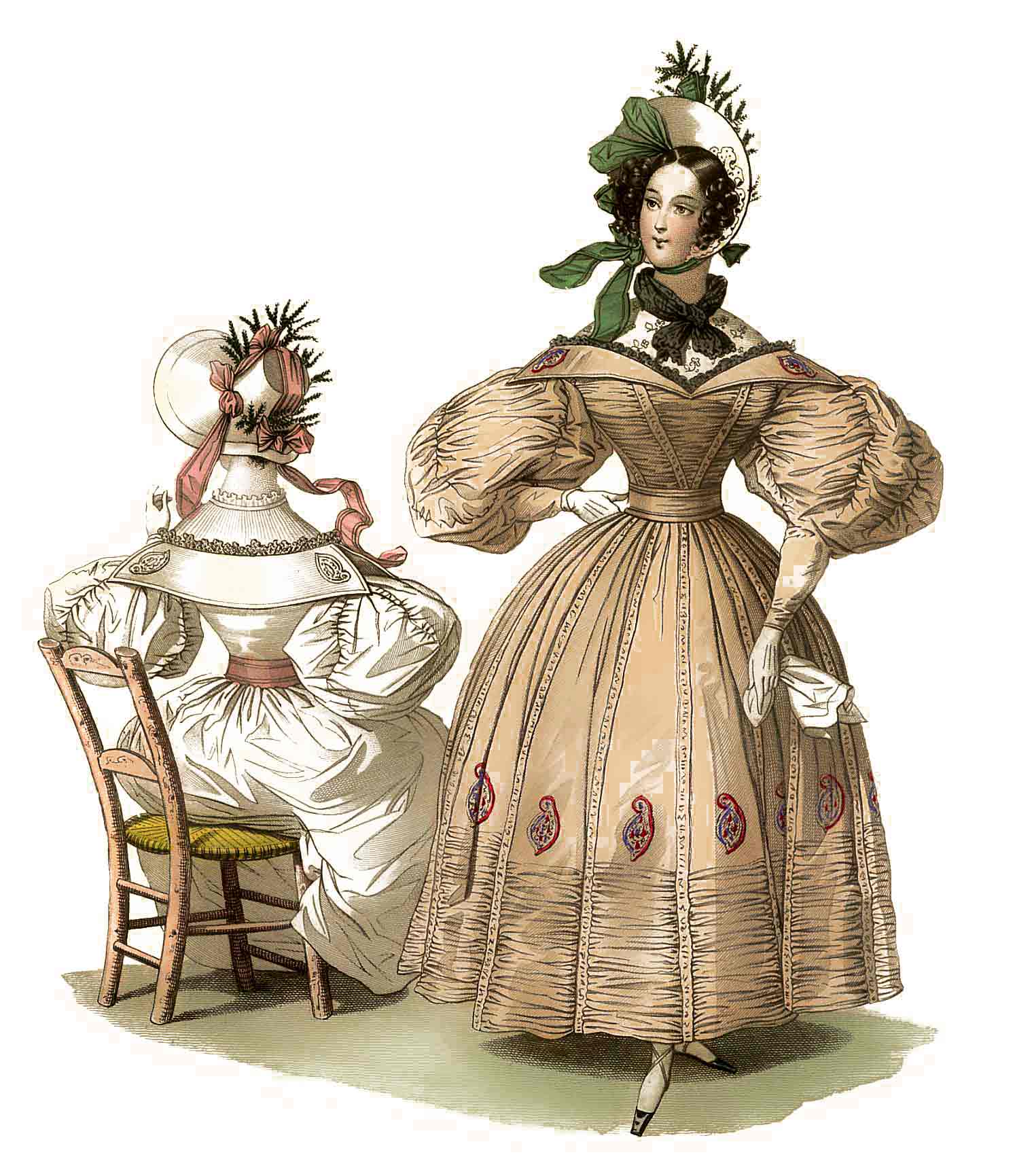
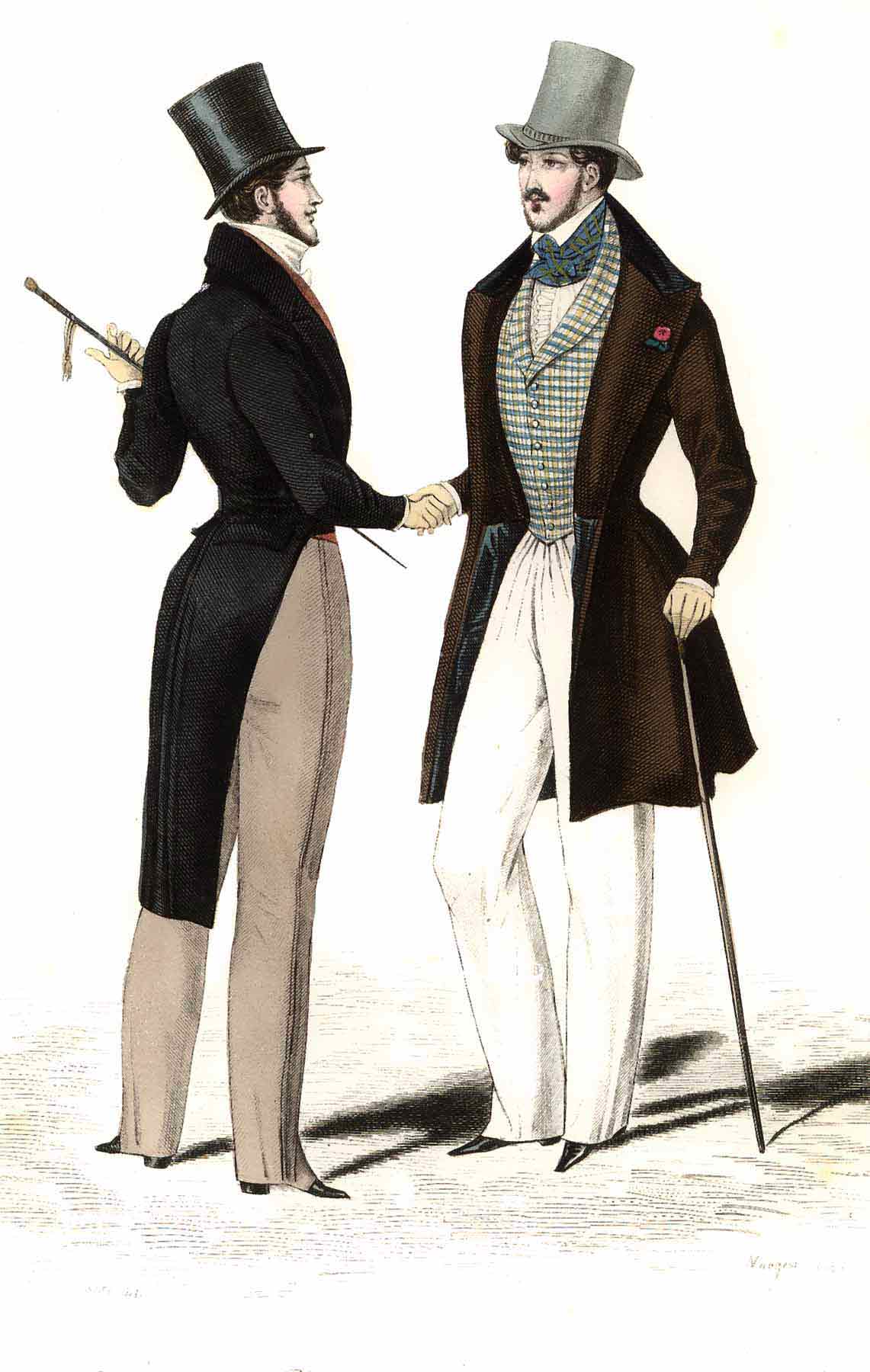
Three days after leaving Hobart Town, Tom D’Oyly celebrated his 40th birthday.7 Four days later the barque arrived in Sydney. The much smaller Jane and Henry was close behind. The Meanwell’s captain was still selling rams at Sullivan’s Cove.
By the time the Charles Eaton arrived at Sydney in July 1834, shipping trade with the Australian colonies was in a healthy state. Sponsored pauper passage had begun and would lead in time to an explosion in the number of emigrants. With the Swan River settlement recently established and two new colonies, at Port Phillip and South Australia, incubating into existence, it was a busy period in the country’s white colonisation. In addition, the Jane and Henry carried London newspapers containing the news that England’s convict hulks were being broken up. Over 8,000 prisoners (including the last 3,000 still left on the hulks) were about to proceed to Australia’s penal colonies.8
The wide harbour was remarkable on both sides for its many wooded coves and inlets but the pilot’s destination soon became obvious. To the west of Sydney Cove was a sandstone outcrop dotted with white cottages, to the east there were the Government House gardens, and to the south a number of tall warehouses. Behind the warehouses was a modern town. At anchor within the cove were a dozen or more merchant ships. Once the barque had a secure moorage, a military guard came on board and took up temporary residence in one of the cabins. His job was to prevent any cargo from being landed without proper clearance.9
If Moore had expected that his small barque would slip into the colony unnoticed, he was in for a surprise. Every merchant ship dropping anchor in or near Sydney Cove had her arrival noted by the shipping reporters of the colony’s four major newspapers. The Sydney Gazette also got in first and secured from Moore the latest news from Cape Town: ‘By the arrival of the ship Charles Eaton, we have received South African Advertisers down to the 3rd May. They do not contain much intelligence of particular interest.’10
So much for Cape Town. Four days after his arrival, Moore berthed his vessel at King’s wharf and the newspapers announced that he was trading, presumably straight off the ship with samples displayed on benches in the now-vacant second-class deck. At the same time, cargo consigned to Sydney had to be unloaded. Consignees already had their bills of lading and they began arriving at the wharf with their drays to collect their goods.
None of Gledstanes’ lead and calico found buyers, but there were still opportunities to sell it at Sourabaya, Singapore or Canton, for spices and China tea. Bright cotton calicoes were popular in South-East Asia while the Chinese market was also interested in cotton shirting calicoes and English woollen goods. The Chinese combined lead with tin alloy and pounded it into paper-thin sheets to line their tea chests. It is likely, however, that for the time being, the lead ingots were doing double duty as ballast. Lead was one of the few trade goods that the Chinese would accept and savvy merchants planning to trade at Canton for tea often found it convenient to have some ingots in their cargo holds.
Gledstanes had prepared for the voyage with great care. Formally, the EIC had the monopoly on trade with Canton. They were the sole importers of China tea to England and they made huge profits from it. An Act of Parliament, passed in April 1834, made trade with Canton available to all British subjects. Gledstanes, confident that the Act was a certainty, had purchased a new ship to couple together the Australian and the Cantonese markets. In the past, many convict transporters and emigrant ships had collected tea from Canton on their homeward voyage, but always under contract to the EIC. Some of them even went whaling for a time – under contract to the EIC. The EIC’s trading monopoly over China angered the residents of the Australian colonies, and they were delighted when the British Parliament revoked it. With Australian imports from England linked to Cantonese exports back to the motherland, the future of the Australian colonies was that much more secure. Australia had yet to seal its own export future with merino wool and minerals such as gold and tin. For the time being, tramping traders and transporters had to work hard to avoid an unprofitable return to England.
Based on a statement by Charlotte that they lived in Sydney during their stopover, the D’Oylys disembarked with the Saltings and went in search of a hotel room. Hot baths, comfortable beds and decent meals would have been the irresistible attractions. After only eight days at sea, Charlotte was already tired of living in cramped cabins with two little boys. There were many neat inns to choose from but since the Saltings finished up in a room at Cumming’s Hotel on Church hill, it’s likely that the D’Oylys went there too.
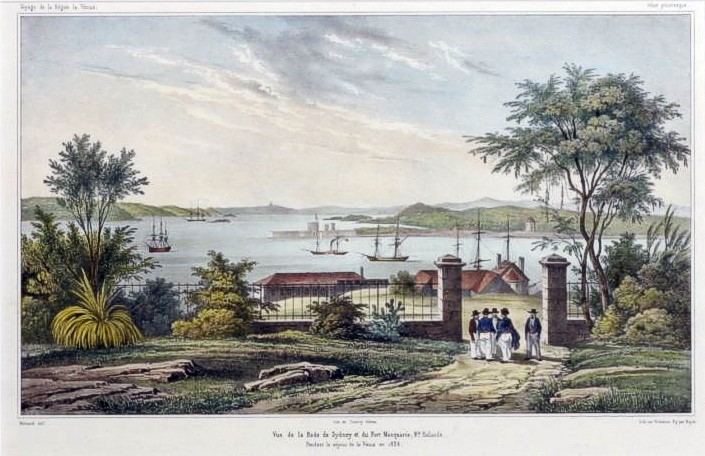
The Saltings had a more pressing need than a conveniently located hotel. With Louisa due to begin her confinement, they had to find a cottage as quickly as possible. Unfortunately, dwellings for rent in Sydney were hard to come by, and four weeks later, on 13 August, Louisa’s child was stillborn in her hotel room.11 One year later, on 15 August 1835, Louisa gave birth to a healthy son and the couple named him George. Their second son, William, was born 18 January 1837.12 Perhaps it was the young parents’ way of expressing fond memories of masters George and William D’Oyly.
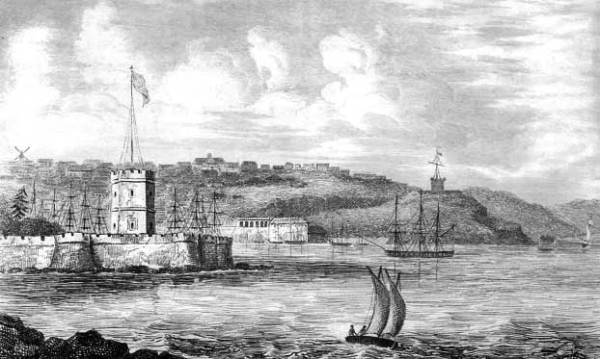
Charlotte and Tom, for their part, had been doing a bit of soul-searching and had concluded that it would be better if their two oldest boys were sent to a boarding school. In a letter to her brother-in-law, received by him on 16 June,13 Charlotte raised with him the need to make further arrangements for her sons’ education. For Tom Jnr in particular, it was time to move him on to the next stage of his journey through life.
There had probably been a time when the D’Oylys had hoped that the boys would follow their father into the Bengal Army’s Addiscombe College. It is questionable whether Charlotte in particular still felt that way. She had shared her years at Chunar with almost 1000 young invalid soldiers – and they were the lucky ones who were still alive. Many young Addiscombe graduates died from cholera soon after their arrival on the subcontinent. It is unlikely that she would have wanted her sons to face that risk. One possibility she raised with her brother-in-law was the Charter House School in London.14 By 1834 it was establishing its reputation as one of the best public schools in England. Bayley had instantly attended to Charlotte’s wishes. He soon discovered, however, that it was now very difficult to get into Charter House. Besides, Tom Jnr was now 13 years old and already too old for entry.
Meanwhile, back on board the Charles Eaton the steward, William Montgomery, had penned a letter to his lady friend in Sourebaya, no doubt advising her of his pending arrival. At the same time George Armstrong had written to a male relative in Ireland. Both letters finished up in Sydney’s dead-letter office because whoever had been tasked with posting the letters had failed to purchase the necessary stamps.
The most likely candidate for the errand to the post office was John Ireland. Looking after the needs of the steward and the first-class passengers was part of his duties. He was a quiet youth but he could be grumpy and lazy. The harsh words likely to have been dished out by Montgomery and Armstrong must have left him feeling resentful at times. It’s likely, then, that he posted the letters but kept at least some of the stamp money to buy rare treats for himself. Armstrong could be pretentious. He insisted upon the title of Mr George Armstrong Esquire because his family owned land in Ireland. No surprise then if his superior airs invited retaliation.
Barring a personality clash, it seems inevitable that the young lawyer, George Armstrong, and the second mate, William Mayor, would have been friends. They were about the same age and they were both financially well off, although Mayor had yet to receive his inheritance. They shared an interest in the shipping trade and had plans for adventurous careers. They would have been impressed with the prosperous town’s pleasant climate and perhaps even a little envious of the Saltings, with their commitment to putting down roots in Australia. It was certainly something the D’Oylys had been considering. Tom’s brother, Robert, had already settled in New Zealand in the ultimately misguided belief that he would amass a fortune there.15 Charlotte and Tom, however, were still fretting about the lack of any news from their two oldest sons in Stockton. Five days after her arrival in Sydney, Charlotte posted her own two letters at the Sydney post office:
Charlotte is chiding the hapless William Bayley, but her letter does contain clues to her emotions at the time. She guessed that her two oldest sons would wonder why their parents decided not to return to England. She disguised her feelings of guilt by focusing on what she perceived as neglect on her brother-in-law’s part, although she must have suspected that insufficient time for an exchange of letters was the real reason for the absence of mail. They had given Bayley no warning of their intention to go to New Norfolk. Both Bayley and their two older sons had continued to address their letters to Calcutta.
The guardianship of the children of those employed in the India service was always a heavy burden for stay-at-home relatives and Bayley was a widower with his own five children to raise. He had just turned 41 and was running one of the largest conveyancing practices in North Yorkshire. He had very little spare time. The Durham Chronicle (15 October. 1847) would say of him:
His countenance was the index of his mind—beaming with intelligence, cheerfulness, kindness, and generosity. He possessed a degree of soundness of judgment and clearness of intellect and ability which bespoke the man of highly-cultivated mind.
Whatever Bayley’s private opinion of the decision not to return to England for Tom’s sick leave, he publicly displayed equanimity. The last thing he needed was a chiding from Charlotte for neglect.
Charlotte’s second letter, despite its scolding tone, is a heart-rending address to Tom Jnr and Edward:
Your father and myself are experiencing the deepest anxiety, my beloved children, in consequence of the length of time which has elapsed, since your last communications were received – Sometimes the painful idea haunts me, that time and absence have effaced us from your little minds, and that we are as entirely forgotten as though we had long since been dead. This thought is so sadly painful, that I try to drive it away, by recalling to mind your dear affectionate ways, when you were both but infants. I am loth to attribute your silence to mere idleness, for I hope that your minds are so properly trained that a wish formed by your parents will be considered in the light of a command, and that the performing of this command will be one of your greatest pleasures. To honour your father and mother, my children, is the command of God, the fulfilling of which carries a blessing along with it, and the neglect a curse. You cannot know how deeply we both feel our absence from you: a firm conviction that we were doing our duty in sending you to England, enabled us to put this separation into execution, and that for the benefit of your education; the same conviction alone enables us to bear up under it, for often, my boys, do tears of anguish flow down our cheeks, because our darlings are far far away; however, could we frequently hear of your health and happiness, our minds would be more reconciled and easy. I hope I have said enough to induce you to write regularly.
We quitted Hobart Town about a fortnight since, and after a week’s trip by sea arrived at this country – take your map, and you will trace our movements. We are now living in the capital of an immense country (Sydney) of which but little is known, possessing a lovely climate. What does not energy of mind accomplish – how does it overcome every obstacle – but a few years back, this spot was unknown to Europeans, it was inhabited by a race of blacks, who are now on the decrease, while the former are increasing wonderfully, and filling the country. Once this very spot was unacquainted with noise, now the bustle of a commercial city reigns throughout. Learn all that is in your power, for by wisdom and understanding all things can be accomplished.
We leave Sydney for Sourabaya next week, where we hope to meet with a ship direct for Calcutta, but we may visit many ports, before we arrive at dear Calcutta, however I am quite tired of this wandering life, and long to get settled. Your beloved father’s health is, through the bounty of a merciful God, quite restored, therefore in this respect I am happy – he is looking rosy and robust, but my heart trembles at returning on his account to the land of the sun, and should he suffer by it, nothing would induce me to remain longer there, for life with him is bliss, without him would be wretchedness extreme. Your brother George has become a fine healthy tall boy, very mild and amiable, and getting on in his studies. Little Willy is in the enjoyment of health, but too young to begin his lessons. And now, may God for ever bless my children – keep his commandments, and be his servants on earth, that at death you may enter into his eternal rest.
I ever am your most attached friend and mother,
CHARLOTTE D’OYLY
Oh what would I give, what would I not give, to kiss my absent lads – God for ever bless you – such is my constant prayer.17
Some images of Sydney Town in the 1830s





.. All Illustrations from M. Dumont D’Urville, Voyage Pittoresque autour du Monde, vol. II. Paris: Furne et Cie, Lib raires-Editeurs, 1839. Based on artwork by M. de Sainson...
Notes to Chapter 4
- Hobart Town Magazine, vol. III, no. 17, July 1834.
- Colonial Times, 15 July 1834. As a point of clarification, Harvey of the Red Rover had formerly been chief mate, but took over the captaincy after her original master, Captain Christie, was lost overboard on the voyage from the Cape. The position was later offered to one of the passengers, the experienced master mariner Captain Walker.
- Hazel King in Australian Dictionary of Biography, vol. 2, 1788–1850, gen. ed. Douglas Pike, Melbourne: Melbourne University Press, 1967 p. 415. Severin, through his firm Flower, Salting & Co., became the wealthy owner of sheep stations and sugar plantations. He died in 1865.
- Sydney Gazette and New South Wales Advertiser, 24 July 1834.
- William D’Oyly Bayley, A Biographical, Historical, Genealogical, and Heraldic Account of the House of D’Oyly, London: D’Oyly Bayley, 1845, p. 155.
- Ireland’s London deposition, The Times, 31 Aug. 1837.
- IGI. Captain Tom D’Oyly was born 12 July 1794 at Wakefield in Yorkshire.
- Sydney Gazette and New South Wales Advertiser, 15 July 1834. It was an optimistic report, for England’s prison hulks continued to exist for several more decades.
- ‘Port Regulations and Orders’, New South Wales Almanack, 1811, quoted in Alan Birch and David S. Macmillan (eds), The Sydney Scene 1788–1960, Melbourne: Melbourne University Press, 1962.
- Sydney Gazette and New South Wales Advertiser, 17 July 1834.
- Australian, 19 Aug. 1834.
- King, Australian Dictionary of Biography, vol. 2, pp. 61–64.
- Bayley file, Bayley to Mrs Robert Williams, 24 June 1834, with reference to Charlotte’s letter, Dixson Library, State Library of New South Wales, Sydney, A1074.
- Known today as the Charterhouse School, relocated in 1872 to Godalming in Surrey. The original almshouse is still located behind St Bartholomew’s Hospital, London.
- William D’Oyly Bayley, 1845.
- William Bayley file, Charlotte D’Oyly to William Bayley, 20 July 1834, Dixon Library, State Library of New South Wales, A.1074.
- William Bayley file, Charlotte D’Oyly to Thomas and Edward D’Oyly, 20 July 1834, Dixon Libary, State Library of New South Wales, A.1074.
Chapter 5: Torres Strait, the widow maker
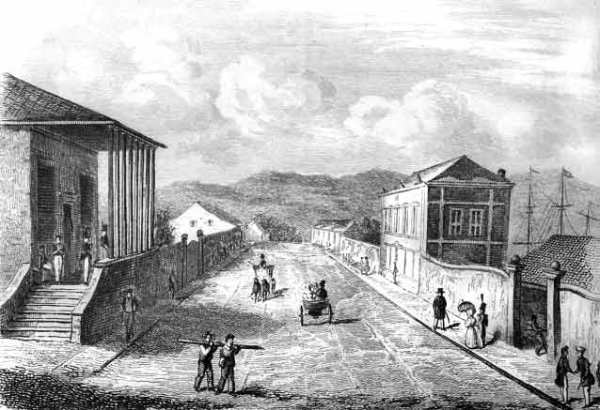
The sailors began their Sunday shore leave with a visit to the respectable side of Sydney and ended it by drifting back to the less censorious delights of the rocky outcrop known simply as The Rocks. Although the whole of the rocky outcrop on the western side of Sydney Cove was famous for its low life, most of the rowdy behaviour occurred on Sundays and centred on a row of crude wooden huts on Lower George Street near King’s wharf, where the ships’ crews hung out. All of the huts were taverns, with the ‘Rum Puncheon’ perhaps the best known and noisiest. On 21 July 1834, while the barque was still moored at King’s wharf, the Sydney Herald published the following remark:
A range of little wooden houses opposite the dock-yards are complained of as being the receptacles for drunkards, and so forth: on Sunday, singing, drinking and fighting are the engagements of the day. If the police were as vigilant as they are formidable, these nuisances would not exist in so public a situation . . .
The dockyard taverns, however, were not the only source of complaint. Flights of steep steps gouged out of the rock led up from the dock to streets and yet more streets. Here the thirsty crews could take their choice of any number of hotels, or cosy cottages used as grog shops. They offered, as additional charms, reel-playing fiddlers, heavy-footed dancers and raunchy, out-of-tune singers. Captain Moore lost his boatswain and two of his crew to the boozy delights of The Rocks, and hired six new men to replace them. When, on the day he was scheduled to sail for Sourabaya (28 July, 1834), Moore signed the required customs certificate, this was his new composition of the crew:
Frederick George Moore, master; F. Grant, surgeon; Frederick Clare, chief mate; William Mayor, second mate; George Piggott, third mate & boatswain; William Perry, midshipman; Tom Ching, midshipman; John Carr, seaman; Charles Robinson, seaman; W. Hill, seaman. William Williams, sailmaker; John Barry (or Berry), seaman; Laurence Constantine, carpenter; George Lourne, seaman; William Montgomery, steward; William Jefferies, seaman; James Wright, seaman; William Grindall, seaman; Richard Quin, seaman; James Miller, seaman; Francis Quail (or Quinn), seaman; James Price, seaman; Samuel Moore, seaman; John Ireland, ship’s boy [plus John Sexton, ship’s boy]
John Sexton’s name was missing from the first official copy of the crew list later issued by Governor Sir Richard Bourke and forwarded to Lord Glenelg at the Home Office. Perhaps it was a transcription error. Or perhaps Moore assumed the ship’s boy had absconded but he returned just prior to sailing. The omission would initially have vexing consequences but later copies of the crew list always included his name. The official document, witnessed as a true copy of the crew list at the time and signed by the Customs House surveyor, Thomas Jeffrey, was subsequently ignored.1
Of the ship’s crew of 13 seamen, or ‘Jacks’ as they were frequently called, five had signed on at Sydney. One of the latter was James Price of Ireland. Another was William Hill, a resident of Sydney. The remaining three were Richard Quin, aged 29, from County Wexford in Ireland, James Wright, aged 19, from Edinburgh in Scotland, and William Grindall, a 22-year-old Englishman from Whitehaven.
In the crowded fo’c’s’le that served as the crew’s quarters, these five men were still outsiders because they were newcomers. Like so many of the boozy sailors rehired at Sydney by captains to replace their own absconded crew, they could be insolent, disloyal and self-serving. Their allegiance was to their third officer and boatswain, George Piggott, who had also just been hired at Sydney.2 William Hill was an exception; he blended in with the original crew.
Moore clearly had some concerns about his men. The Sydney Monitor twice published the standard notice from him advising that he would not be responsible for any debts incurred by his crew. Captains were heartily sick of the pimps and touts who preyed on drunken sailors and encouraged them to spend all their wages in advance. They would then front up to their victims’ captains with hefty invoices, demanding payment for services rendered. Sydney’s Rocks area was notorious for that kind of over-servicing.
Of more interest to Moore once the crew had been sorted out was a notice posted at the abandoned navy dockyard next to King’s wharf, where it could be seen by any sailors who went there to fill their water kegs at its taps:
It being intended that His Majesty’s Ship Alligator should sail for India forty-eight hours after her arrival from Norfolk Island, proceeding through Torres’ Straits, Captain Lambert will be happy to convoy any ships going that route, should the masters of them wish to avail themselves of the opportunity.3
HMS Alligator would be departing too soon to be of benefit to Moore. The notice was a timely reminder all the same of the dangers ahead – and one that the captain heeded now that he was about to proceed with his ship to the Strait. Moore was a professional navigator and he was confident of his skills. He was unhappy with the chart he had brought with him from London, and obtained a copy of a map compiled by Captain Samuel Ashmore – Sydney master mariner and ship owner. It was Tracks through the Barrier Reefs of N.S.W. by Capt. Ashmore and Others 1822 to 1830 and it roughly indicated a number of passages through the Barrier Reef that had been used previously by ships approaching the Torres Strait.4
Mariners were well aware of the Strait’s reputation as a ship-wrecker and they greatly feared it. It cried out for a properly surveyed chart, with every obstacle and deep-water channel laid down. No such chart yet existed. Most mariners knew, however, that one of the easiest ways to reduce the risk was to pass through the strait in the company of another ship. If one vessel founded on a reef, the other would be on hand to rescue the crew. The Jane and Henry’s master, Captain Cobern, had originally planned to sail on 25 July for Batavia, but decided to leave in company with Moore instead. There is some reason for believing that Cobern had no chart of the Barrier Reef entrances and was relying on Moore to act as his guide.
Moore had failed to secure any bales of merino wool for the return journey, or even any of His Majesty’s troops. Nor was he freighting any whale oil. In his hold, there were still 37 bales of woollens, seven cases of muslins, the 410 lead ingots, and a large quantity of calico bales. Of Gledstanes’ own adventure cargo, Moore had sold their alcohol at Sydney – and little else.5 Based on his projected route, there is good reason to believe that this had been Moore’s expectation all along. As a former officer in the EIC’s merchant navy, he had ample first-hand knowledge of South-East Asian trade. By calling at Sourabaya, he would very likely sell more of his cargo, while at the same time picking up freight (rice, spice, sandalwood) for either Singapore or Canton. He could then restock his hold with Chinese exports such as tea, silk and china goods. The barque was primarily a tramp trader and her prospects were now very good. In the first year after the abolition of the EIC’s trading monopoly, the export of China tea to Britain increased by about 30 per cent.

The Charles Eaton and the Jane and Henry left Sydney together on 29 July and headed up the eastern coast of Australia on the ocean side of the Great Barrier Reef. The alternative route between the reef and the coast had been well surveyed by Phillip Parker King R.N. King was a vigorous advocate of the inner route and he was held in high regard as a hydrographer. Despite this, most British merchant ships used the outer route. They were exposing their ships to boisterous weather but the open sea was largely free of hidden hazards. All mariners agreed, however, that the main drawback to the outer route was the great risk involved in finding a safe passage through the Great Barrier Reef to the Torres Strait. If, at the time of approach, bad weather blew up and reduced visibility, the chance of dashing the ship against a reef was very high.6
For the first two days of their voyage, the crew aboard the Charles Eaton enjoyed fine weather and favourable winds. On the third day, an accident briefly disrupted their pleasant routine. Chief mate Clare was guiding an anchor onto its hook at the bow when the pole he was using snapped and he toppled overboard. John Ireland later described his rescue. ‘We immediately stopped work and let down the boat,’ he said, ‘and he being an excellent swimmer, was able to keep up until the boat reached him.’7
On the day following Clare’s accident, a gale replaced the pleasant breezes. The Jane and Henry was too slow to keep up with the much larger barque,8 whose sails soon vanished below the horizon. If the two ships really were sailing together for safety, as reported in the Sydney press, then Moore’s action in forging ahead of his companion vessel was foolhardy to say the least.
On the fifth day of the voyage, William D’Oyly celebrated his third birthday. John Ireland, who watched the two brothers playing together in the cabin passage as he went about his chores, guessed that George was eight years old and thought that William, who was probably more unsettled by the voyage, was aged about 15 months.9 His older brother had a mild disposition and was a much more stoic child.
For almost nine months, the crew made do with the fo’c’s’le. Now at last the steerage and most of the cabins were empty. There was plenty of space for the men to spread out. Up in the poop the cuddy had also become more convivial. Even the usually inconspicuous George Armstrong seems to have loosened up and joined in the party mood. The barque was still carrying some casks of wine and beer for onboard consumption. Unlike water, which turned foul on long voyages, it improved with age.
When his barque was almost parallel with Cape York Peninsula, at the northern tip of Australia, Moore changed course and sailed back towards the mainland. On the evening of 14 August 1834, the barque was close to the point where Moore planned to cross through a gap in the Barrier Reef then proceed to the Torres Strait. Although there are many safe channels through the Great Barrier Reef, merchant vessels in the 1830s used a group of four or five tracks,10 between latitudes 12°8′ and 11°47′ south. Sir Charles Hardy’s Island is one of the few islands off Cape York Peninsula that mariners could clearly see from the Reef. There are actually two islands close together, but sailors in the early nineteenth century referred only to the larger island. A lofty chunk of volcanic rock, it was an important landmark for early mariners, who took their bearings from it before attempting a crossing.
One of the tracks in the group near Sir Charles Hardy’s island is via the Indefatigable entrance, named after the first vessel to use it. Although popular for a time, it was a risky choice for an entrance. A large detached reef lies in the path of any vessels approaching it from an easterly direction.11 This reef is about 12 miles (20.8 km) long and bears southwest to northeast.12 It snakes along the general line of the Great Barrier Reef and can be considered part of it, although it has its own name as the Great Detached Reef. This is no small, submerged rock ready to trap the unwary, but a massive obstruction that ships can avoid without difficulty – providing visibility is good.
When Moore sighted Sir Charles Hardy’s Island, it was raining and blowing a gale. Not wishing to pass through the Great Barrier Reef at night, he ordered the reefing of the topgallant sails, to reduce canvas and slow his vessel down. ‘However, at daylight the next morning we again set sail,’ said John, ‘although the wind was very high and the water getting rough’. Even the cabin boy, blessed with the wisdom of hindsight, thought that the captain was being foolhardy. There were so many heavy clouds that Moore was unable to take a reading for latitude. Yet it would appear that he had managed to line up his vessel for a direct approach from the east to what he fairly calculated was the Indefatigable entrance. We can assume, too, that Moore placed lookouts at the mastheads. Armed with that necessary precaution, Moore steered boldly for the entrance, unaware of the hidden obstacle lying directly in his path.
The Barrier Reef is a magnificent spectacle. The closer you get to it, the more it presents itself as an unbroken line of white surf, as waves hit the coral and shoot up into the air in clouds of spray. Nineteenth-century mariners, with no accurate charts to guide them, sailed parallel to the white spray and the foaming waves at a safe distance until they encountered a wide gap of calm sea. Moore found such a gap in the surf and assumed from his charts that it was the Indefatigable entrance. He was mistaken. The Great Detached Reef bends and twists and must have created the illusion that there was a gap that he could safely pass through.
By the time Moore realised his error, it was already too late. The helmsman attempted to tack, but the barque responded slowly, continuing to bear down upon the breakers. There was, however, still time to prevent a collision – or so it appeared. The crew dropped both anchors and fully played them out. They found no holding seabed. There was too much depth on the seaward side of the reef. The barque ploughed into the reef with a splintering, sickening crunch. Her keel and rudder dragged and splintered across the coral until it wrenched them off and the sea carried their remains away. The barque fell broadside and the sea briefly swallowed her. When the waves receded, debris littered the upper deck. The large longboat, carelessly tethered it would seem, had slid across the deck and been dashed to pieces against the bulwark (railing). The tiny jolly boat had suffered a similar fate. The two small cutters on the quarterdeck, however, were secure and they both survived the collision intact.
Charlotte D’Oyly was in her cabin, trying to drinking a cup of coffee essence while William slept beside her in one of the bunks. She would have known that the barque was approaching the most perilous part of the journey, would have heard the roar of the waves. John Ireland was going about his chores when the sea flooded into the cabins. Within seconds, a panicking Charlotte joined him. ‘The distracted mother instantly ran on deck in alarm,’ he later reported. ‘I went into the cabin, where I saw the poor child [William] washed out of its berth, and crying on the floor.’ Fearing he would drown, John carried the boy to his mother, who thereafter never gave him up to another’s care. In a similar way, Tom now attached himself firmly to George. Faced with such overwhelming and immediate peril, Charlotte and Tom made the safety and survival of their sons their paramount concern.
.

Sailors were accustomed to dealing with emergencies and once they were over their initial shock they tended to act with commendable speed. At this point, said John, the chief mate ‘cut away the masts’.13 It was a common response to a shipwreck, since the combined weight of the superstructure, including rigging and sails, was considerable. Captain (later Admiral) Phillip Parker King was in no doubt that Clare cut away at least some of the masts. Clare’s swift action made no difference to the barque’s perilous position, and she remained impaled upon the reef.14
A quick inspection revealed that the hull was broken and water flooding into the hold and lower deck had already completely spoiled everything they contained. The vessel was unquestionably doomed. Fortunately, the upper decks were reasonably intact, ‘though there was so much danger from the water rising,’ said John, ‘that everyone expected to be washed over.’ The situation called for calm and order. Instead, Captain Moore announced that the barque was lost and ‘ordered the boats to be got ready and furnished with provisions, to save the ship’s company and try to reach Timor.’ He expressed regret, said John, at the ‘stern necessity which urged him to such a step in such a sea.’ There was just one problem. The smaller of the two cutters could safely carry about six people, while the larger cutter could probably squeeze in a dozen. The other two boats were shattered and useless. If the 13 sailors carried out the captain’s orders, most of them would be left behind to perish.
There was so much confusion it was inevitable that conflicting accounts would emerge. One thing all eyewitnesses agreed on: when the crew launched the small cutter, too hastily and unwisely, one of the newcomers, James Price, leapt aboard it, only to drown in the heavy surf when the cutter immediately swamped as she hit the water.
In the wake of the disaster with the small cutter, Moore came to his senses. The Charles Eaton had settled on the reef and there was a good chance the upper decks would remain intact for some time. It would be pointless to launch the second boat in the heavy swell. Instead, he announced without acceptable alternative, they would hold onto the ship. At least some of the crew, however, had a different plan. Three of them tossed a couple of kegs of stores and the carpenter’s tools into the remaining cutter, released her from her lashings and safely launched it. ‘They thought only of themselves and made no attempt to assist those on board but after getting what they could from the wreck made off,’ said John, and he was still angry about it many years later.
The men who took the large cutter later staunchly maintained that the captain and the two mates were present at what would otherwise have been an impossibly hasty and surreptitious launch on such a crowded deck, but their account conflicts with Ireland’s later claim that they selfishly seized the boat. What we do know is that a strong current caught the boat, sweeping her away and depositing her on the leeward side of the reef. Her occupants were Laurence Constantine, the American carpenter, the boatswain and acting third officer, George Piggott, and the 22-year-old English sailor, William Grindall. One of the men in the cutter later gave this version of the reaction to their departure: ‘the Captain and the officers were asked to join, they refused however to do so, saying the boat had no chance of escape’.15 The rest of the crew and the hapless passengers received no such invitation.


Suddenly someone spotted another vessel, about three or four miles (five or six kilometres) to windward. For a brief moment, everyone thought that rescue was already at hand, and cried out with joy and relief. Then they realised that it, too, was stuck on the reef, with masts standing, royal yard arms crossed and sails set.16 John heard Moore confess ‘that he was sorry he had not made use of his own chart, instead of one that he bought at Sidney [sic], lest there might be any mistake in his own.’17
As the day wore on and the tide receded, calm and discipline prevailed. The passengers inspected the flooded cabins at the stern and were heartened to find that their circumstance, though grim, was not yet hopeless. The D’Oylys still had a large chest of dry clothing, although Armstrong was not so lucky. All his spare clothes were lost. There were some kegs of salted pork, plus water, biscuits and beer. Incredibly, the steward recovered some unbroken wine glasses from the cabin pantry. The poop was badly damaged but still capable of providing shelter.
The sailors were a good deal less fortunate, for their sleeping quarter was at the bow. Fo’c’s’les, as every sailor could testify, were barely fit for human habitation. Even under the most favourable conditions, they were dirty, smelly, wet, cramped and dark. Now, however, one side of the bow was a gaping hole. The men who sought shelter in the fo’c’s’le were cold and uncomfortably wet – and with nightfall, they were exceedingly frightened. Above the howl of the wind and the din of the sea, they could still hear the sounds of more and more planks being wrenched from the sides of the hull. As John put it: ‘we felt that we were approaching nearer and nearer to a death from which we could not hope to escape’. The superiority of the stern cabins, however, was an illusion. With each strong wave, more planks were tore off and washed away.
Dawn brought relief and a surprise. The cutter containing the carpenter and the two other sailors was still in the lee of the reef. Having no grapnel with which to secure their boat, the men had held their position by rowing all night. In the aftermath of the wreck, the panicking seamen had launched themselves to safety in a boat then waited around to see what happened next. Once their terror had subsided, they were reluctant to leave their ship’s vicinity, hoping perhaps for a rescue ship or a miracle. In the ocean’s seemingly endless emptiness, the disintegrating wreck was still their familiar hearth and home.
Two of the sailors on the wreck now decided to take their chances with the cutter, by swimming across the reef. They were Richard Quin and James Wright. John, however, believed that Quin and Wright had conspired with Constantine and Piggott, and that the three men in the cutter were simply biding their time and waiting until it was safe for their two friends to join them. Since both these men also joined the barque at Sydney, the cabin boy’s version does have credibility. That four newcomers were among the five men in the cutter is unlikely to have been a coincidence. They were ‘loose cannon’ not yet tied by bonds of respect or friendship to Moore and their new shipmates. Of those in the cutter, only Constantine had been with the barque for the whole of her voyage.
Six other sailors also dived off the wreck and swam over the reef towards the cutter. As soon as Quin and Wright reached the boat, however, she was immediately sailed away. The cutter was big enough to take another six men but had barely enough stores to keep five men alive for several weeks. The men in the cutter were not interested in trying to save as many people as possible, John thought. They were only interested in saving themselves. One of the cutter’s occupants (unidentified) later claimed that their last view of the Charles Eaton ‘shewed part of the lower and upper deck beam standing high out of the water, part of the poop however was standing, in which it appeared as if the crew and passengers had taken shelter.’18 Quin, however, stated that when he abandoned the barque all of the passengers and crew were gathered together on the f’c’s’le deck at the bow.19 As for the six sailors who had also tried to reach the cutter, they returned to the wreck dripping water and venom, in no doubt that they had been cruelly abandoned. Captain Moore and the D’Oylys, however, had witnessed their willingness to flee the scene.
A day or two later the poop finally disintegrated and much of it was carried away by the surf. Charlotte and Tom had managed to rescue their chest of clothing before their cabin flooded and they now donated its contents to the general pool. John later expressed gratitude for ‘the kind manner in which they requested us to make use of any of their clothes, part of which were the only ones saved’. The cabin passengers on the crowded main deck were rubbing shoulders with rough sailors and a spirit of equality appeared to prevail.
The men had a consultation about what to do next and it was at this point that Tom D’Oyly probably took a more prominent role. Tom had spent two years at the EIC’s Addiscombe College and his studies had included civil engineering. He knew how to construct anything from the simplest of rafts to pontoons, bridges, dams, survival distilleries, roads and artillery fortifications – and had the training to do it with whatever materials and tools were at hand. He also must have had the mechanical engineering knowledge necessary for maintaining his ordnance. He could confidently assure Moore that they would be able to use the materials around them to make a raft big enough to take them all. The plan was to sail the raft to the mainland, some 40 miles (66 km) away. By sailing northwards up the coast they might, with luck, reach the mouth of Escape River. If they found fresh water there, along with some shellfish and roots, it would dramatically improve their chances of survival. There was also a chance that a passing ship’s crew would spot their raft.
According to John, everyone went on a daily ration of a few pieces of broken biscuit and two wine-glassfuls of water, while the men set to work on building the raft. There were, however, still a few casks of salted pork, wine and beer. There were those on the wreck who ate broken biscuits and there were those who probably fared a little better.
With the steerage deck awash, the main deck was now the only place where everyone could safely congregate. It also had to hold the few provisions that they had managed to save, plus the materials they needed for the raft. There was so little space that people kept bumping into each other.20 The raft was limited in its dimensions by the size of the space available for the men to work. The other problem was the very small supply of water and someone hit upon the idea of constructing an evaporation plant. The steward kept the quarter galley coppers filled with seawater. A funnel was fashioned to channel the steam through a long condensation pipe, and the fresh drinking water that dripped from its end was collected in casks and bottles. The spare masts and spars and much of the timber had coatings of tar, so dry woodchip was available. Of the coal hole I’m not so sure. It was well and truly under water. John Ireland was probably involved with the steward in the simple but important task of keeping the galley fire burning, for he later stated with some pride that the condensed water was ‘one of the greatest helps during our stay upon the wreck.’
The most useful description of what conditions must have been like on the wreck was supplied by John, when he mentioned that the steerage had been flooded to a depth of about four feet (1.2 metres), with everything else above that level still high and dry (so to speak). Everyone had to find their own cubbyholes in what was left of the fo’c’s’le and the poop, with crates and sheets of calico doubtless providing additional protection from the elements. The main deck at night must have resembled a makeshift camp. During those long, dark and sometimes squally nights aboard the wreck, the passengers, the surgeon and the captain would have stuck together in a huddle for mutual comfort and there is a very good chance that they plotted their own survival. Next time, if needs be, it would be women and children first.
August can be an unsettling month in the region where the survivors were marooned, with clear skies repeatedly invaded by storm-bearing clouds. On particularly fine days, with the sun on their faces and the wind flapping their sleeves, it must have been easy for the now industrious party to believe that providence would be kind. Their ship had settled into the reef and was holding fast, in a conspicuous position on the sea route from Sydney to South-East Asia. The reef was reachable and there were many strong men to rummage around underwater for edible crustaceans. Other sailors may have rigged up fishing lines and dangled them over the side. Despair had given way to a glimmer of hope. Everyone wanted to believe they could survive the disaster that had befallen them.
John thought that it took about seven days to build the raft, although later events suggest it was probably much less than that.21 They were greatly hampered in their labour by not having any carpenter’s tools since Constantine had taken them with him. They had to make do with axes, knives and ropes. With so many willing pairs of hands at work, it must have been quite a raft. It had to be. Their survival depended upon it.
With each high tide, the barque lost a few more timber planks and as the days passed, it became a cause for increasing alarm. At low tide, the men swam through the hatches and down into the hold, trying to find any stores or water casks that might have been overlooked on previous dives. They found nothing except some calico, which Williams the sail maker used to make the raft’s sail. As for the kegs of water and stores, most of those had long since floated away. By the light from the holed hull and the open hatches, the swimmers would have seen many reef fish, already exploring the unexpected addition to their territory.
Throughout their long ordeal aboard the disintegrating wreck, Charlotte D’Oyly and her Indian nurse remained remarkably calm, expressing gratitude for services rendered and with Charlotte and Tom ‘extolling the sailors to further effort’. In later years, John would forget many of the details of his time on the shipwreck but he did remember their encouraging words of praise.
By the time the raft was finished, stores were very low and everyone knew it was time to go. They could no longer afford to wait around for the Jane and Henry or any other rescue ship. They gently lowered the raft into the water and the D’Oylys, their ayah, Armstrong, the surgeon and the captain climbed down onto it. Moore’s dog, shaggy-haired Portland, also took to the water. He was an excellent long-distance swimmer and loyally followed his master. He was also, potentially, fresh meat. Also on the raft was a basket containing all of the distilled water, a cask of pork and some beer (or possibly broken biscuit). Then the crew scrambled down to the raft and they cut its holding ropes and let it drift away.
As soon as they reached deep water, it was clear the raft was not buoyant enough to take them all. It sank beneath them until they were standing waist-deep in water, and it was so unstable that it threatened to capsize. In a panic, the men turned around and frantically paddled back to the wreck. One frightened sailor carelessly jettisoned a basket containing provisions. The two mates, Clare and Mayor, then led the way for their crew by climbing back onto the wreck, while Moore remained on the raft with the passengers and the surgeon. The steward, Montgomery, was unable or unwilling to abandon his role as the passenger’s servant. John, however, preferred to follow the chief mate. Two strong seamen, Lourne and Berry, also remained on the raft. In the end there were 11 people on the raft while 10 men, the two midshipmen and the two ship’s boys returned to the wreck.22 To prevent the raft from drifting away, it was firmly attached to the stern with a new rope.
It is possible now to view the first raft as a planned-for contingency, albeit ultimately executed out of genuine necessity. Its occupants included all of the passengers and the two most senior members of the ship’s company, Captain Moore and Surgeon Grant. Montgomery was the passengers’ servant and two strong seamen handled the heavy oars. The first raft had also taken all of the water, most of the weapons and the bulk of the food supplies.
By nightfall, the sailors on the wreck were asleep, satisfied that Moore would not abandon them. Tomorrow, he had promised them, they would begin work on strengthening the raft so that it could take them all. Either that or they would build a second raft. Common sense dictated that Moore should set sail and go. For the D’Oyly family the predicament must have been increasingly ridiculous. Waves over the reef would have been bouncing them against what was left of the stern, with Charlotte and Tom struggling to protect and comfort their two terrified sons in the face of this new but still unbearable peril. William, in particular, would have been sobbing throughout the entire ordeal. At some time in the middle of the night, when all the sailors were asleep, someone slashed the rope that tethered the raft to the stern. When the crew awoke next morning, the raft and its occupants had vanished.
….….
Notes to Chapter 5
- Historical Records of Australia, vol. XVIII, p. 575. Also Thomas Wemyss, Narrative of the Melancholy Shipwreck of the Ship Charles Eaton . . . , 2nd Edn, Stockton-on-Tees: J. Sharp, 1884, p. 47. The official crew list from the customs office included William Hill and omitted John Sexton, while the Batavia deposition of the four surviving sailors, omitted Hill and included Sexton. It was based on the crew list ex-London and contained several mistakes.
- For information about the crew ex-London see Ireland, The Shipwrecked Orphans, New Haven: S. Babcock, 2nd edn, 1845, p. 4.
- Sydney Herald, 14 July 1834.
- Allan McInnes, ‘The Wreck of the Charles Eaton’, read to a meeting of the Royal Hist. Soc. of Qld, 24 February 1983; Samuel Ashmore, letter dated 13 May 1836, Nautical Magazine, vol. 6, no. 4. pp. 211–14.
- Sydney Monitor, 30 July 1834.
- See for example Phillip Parker King, letter, 1 December 1832, Nautical Magazine, vol. 11, no. 18, August 1833, pp. 433–35.
- John Ireland, The Shipwrecked Orphans, p. 8. All quotes attributed to John in this chapter come from this book. His oral account, however, has been either refined by the publisher or adapted from other published sources. Because it’s a small book I have chosen not to endnote every quote.
- Phillip Parker King, Voyage to Torres Strait in search of the Survivors of the Ship “Charles Eaton” . . . , Preface, Sydney: the NSW Govt., 1837.
- Ireland’s London deposition, The Times, 31 Aug. 1837.
- They included the Nimrod Passage, Brown’s Passage, Stead Passage and the Indefatigable entrance. Of these, the Stead Passage was arguably the most popular with mariners because it was almost due east of Sir Charles Hardy’s Island and therefore easier to locate. Its main disadvantage was Yule Reef, which lay in the path of approach from the southeast and had to be carefully avoided.
- The Indefatigable (Master Matthew Bowles, retired Lieutenant RN) left Sydney on 13 July 1815 in company with two other vessels. Bowles stumbled across a passage through the reef more by luck than skill and the three ships were almost immediately surrounded by a labyrinth of dangerous sand bars and reefs. They spent the next two or three days torturously weaving a zigzag track through the reefs until finally rounding Cape York Peninsula. That the Indefatigable passage was subsequently indicated on some maps was perhaps regrettable, given that there were better tracks. For an account of the Indefatigable’s voyage see Ian Nicholson, Via Torres Strait: A maritime history of the Torres Strait route and the ships’ post office at Booby Island, Roebuck Society Publication no. 48, Nambour, Qld, 1996, pp. 45–48.
- J. Beete Jukes, M.A. F.G.S. Narrative of the Surveying Voyage of H.M.S. Fly . . . , 2 vols, vol. 1, London: T. & W. Boone, New Bond Street. 1847, p. 328. Jukes supplies this description of the Great Detached Reef: ‘Six miles N.N.E. of Yule Reef there commences a large detached reef of irregular outline, twelve miles long from north to south, bounded on three sides by an almost continuous mass of reef, but open on its western or leeward side, where is an irregular-shaped bank of soundings, with patches of reef upon it. Inside the lagoon of this detached reef there is a depth of 20 to 30 fathoms, but outside the reef the depth is very much greater, and generally unknown. There is a passage five miles wide between this detached reef and the line of the Barrier, in which bottom was reached in two places, once with 105 and once with 135 fathoms, fine sand being brought up on the lead. On other places ineffectual soundings were tried with 130 and 150 fathoms of line.’
- Phillip Parker King, Voyage to Torres Strait in search of the Survivors of the Ship “Charles Eaton” . . . , Preface, Sydney: NSW Govt., 1837, p. v.
- It may be useful to compare Clare’s action with that of the chief mate aboard the Stirling Castle, wrecked on Eliza Reef on 25 May 1836: ‘To ease her, Baxter suggested cutting the main rigging, and soon after this was done a violent surge carried away the mainmast complete with the foretopmast and all the complicated superstructure of a ship in full sail.’ In Michael Alexander, Mrs Fraser on the Fatal Shore, London: Michael Joseph, 1971, p. 28. This action of cutting the rigging to bring down the masts was described as contriving to ‘cut away the masts’ in ‘Wreck of the Stirling Castle’, Tales of Travellers; or A View of the World, no. 48. 2 Sept. 1837. Other stories of that era, however, indicate that in particularly perilous circumstances some of the masts were literally felled like trees.
- Australian, 3 May 1836.
- Phillip Parker King’s belief that this was the wreck of the Flora (grounded on Detached Reef 1 May 1832) has been queried because it’s difficult to see how she could have survived intact for more than two years. Her captain, Sheriff, described extensive damage to the rigging even before the crew abandoned it. (Nautical Magazine, vol. II, Oct. 1833, pp. 595–98.). The captains of the Strathfieldsay and the Asia sighted a wreck high on Detached Reef in September 1833, when they were passing through the Indefatigable entrance. It was then in such a sound condition as to appear to have only recently been abandoned by her crew. (Nautical Magazine, vol. III, no. 34, p. 712). Then the ship Othello with the barque Planter in company approached the Detached Reef on 23 May, 1834, and Surgeon Mitchell of the Othello reported in his journal: . . . ‘we saw within the reef upon a sand bank the wreck of a large ship her lower masts & Topmast were standing with yards across and the sails had been blown away from them the boltsprit Jib and flying jib boom were standing the sails stowed, the fore and main spencers were brailed up the bulwarks break of the poop and every thing on deck appeared to be washed away she was lying upon her beam ends and appeared to have been lost recently’. At the time of their approach to the Indefatigable entrance, visibly was so poor that the two vessels tacked back and forth for three days before they were game to tackle the entrance. Even so, they had no difficulty in sighting the wreck. The description of the location of the wreck is consistent with that of the Flora’s final resting place. The crew and sole female passenger of the Flora took to the longboat and they did make it safely to Timor.
- If Moore’s own chart was an Admiralty chart, he would not have been much better served, since it, too, gave only a rough idea of the Detached Reef’s dimensions. Moore’s action in bearing away to the reef under adverse conditions was one for which he alone was responsible. Alluding to the dangers of such an action when approaching the Barrier Reef from the outer passage, Phillip Parker King wrote of ‘the possibility, nay, the probability, of thick weather preventing the sight of the land-marks, or, of not being able to procure an observation for the latitude, without which no prudent navigator would feel justified in venturing to bear away to leeward, for any particular passage through the Barrier Reef’ (Nautical Magazine, vol. II, no. 18, 1833, p. 434.)
- Australian, 3 May 1836.
- William Bayley file, Batavia deposition, Dixon Library, State Library of New South Wales, A.1074. The sailors’ Batavia deposition was copied by Gledstanes & Co. and circulated to interested relatives.
- Ireland, The Shipwrecked Orphans, p. 13.
- Although seven days seems a long time to build a raft, the party may have delayed starting in the belief the Jane and Henry would rescue them.
- One account by John Ireland puts 10 people on the first raft and 15 left behind on the wreck. Based on the names he supplied at different times, however, there would have been 11 people on the first raft and 14 on the wreck.
……..
Addendum to Part One: the charts
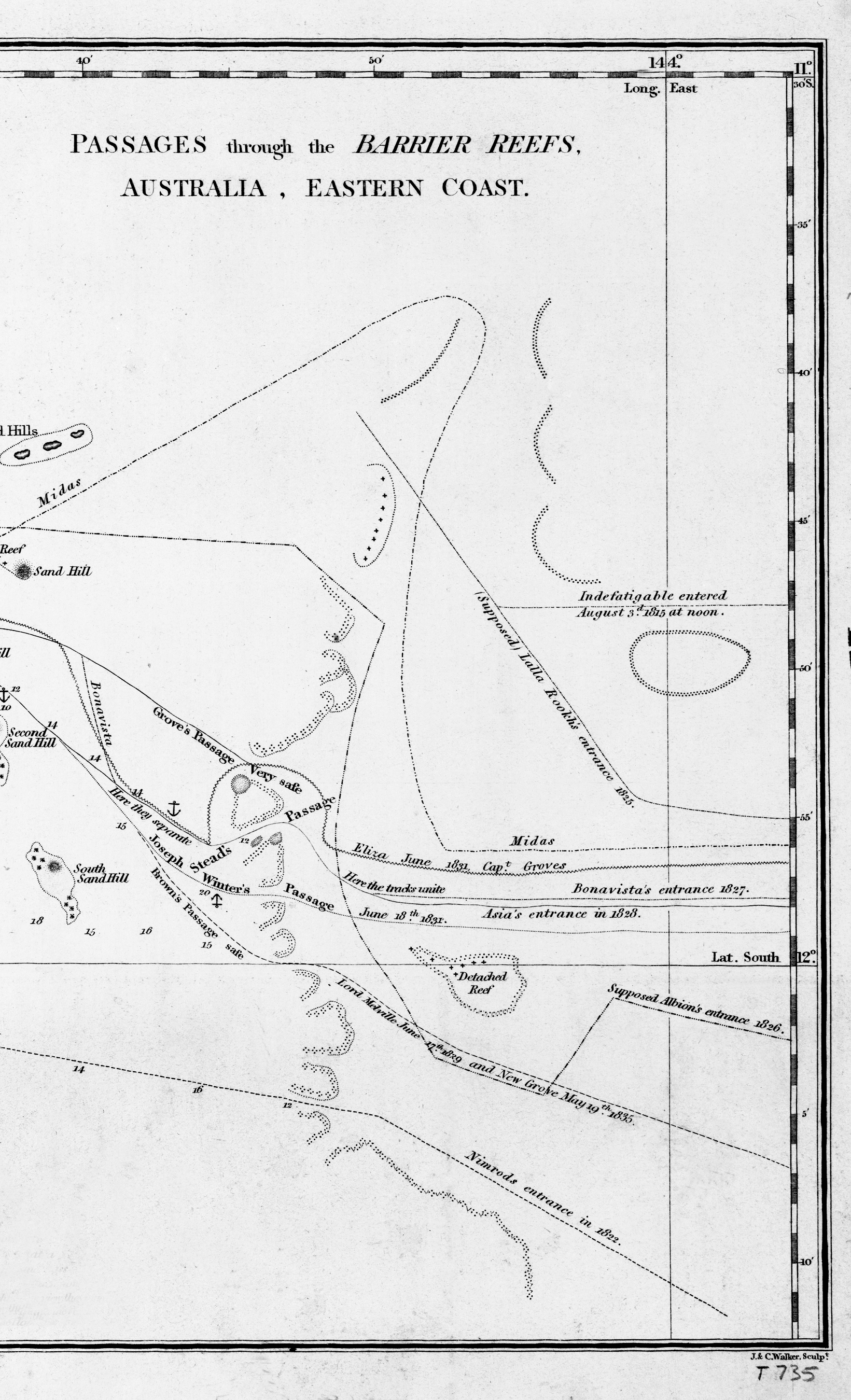
Before Captain Moore left London, he obtained a copy of Horsburgh’s 1832 chart. We can accept that because he said that he had got a chart of the area at London, and the 1832 version of this one was the current one then available. Horsburgh’s charts were among the most trusted in the world, renowned for their accuracy. In this instance, however, he has produced a sketch based on information provided by ship captains, and it is consequently vague. The Great Detached Reef is given a simple oval shape but he has placed it reasonably correctly in terms of its longitude. Giving the Indefatigable entrance a latitude of approx. 11°47′, however, puts ships on a collision course with the Great Detached Reef. It is dangerously misleading. A copy of the chart has been digitized and can be viewed at the National Library of Australia website. I recommend that you check it out.
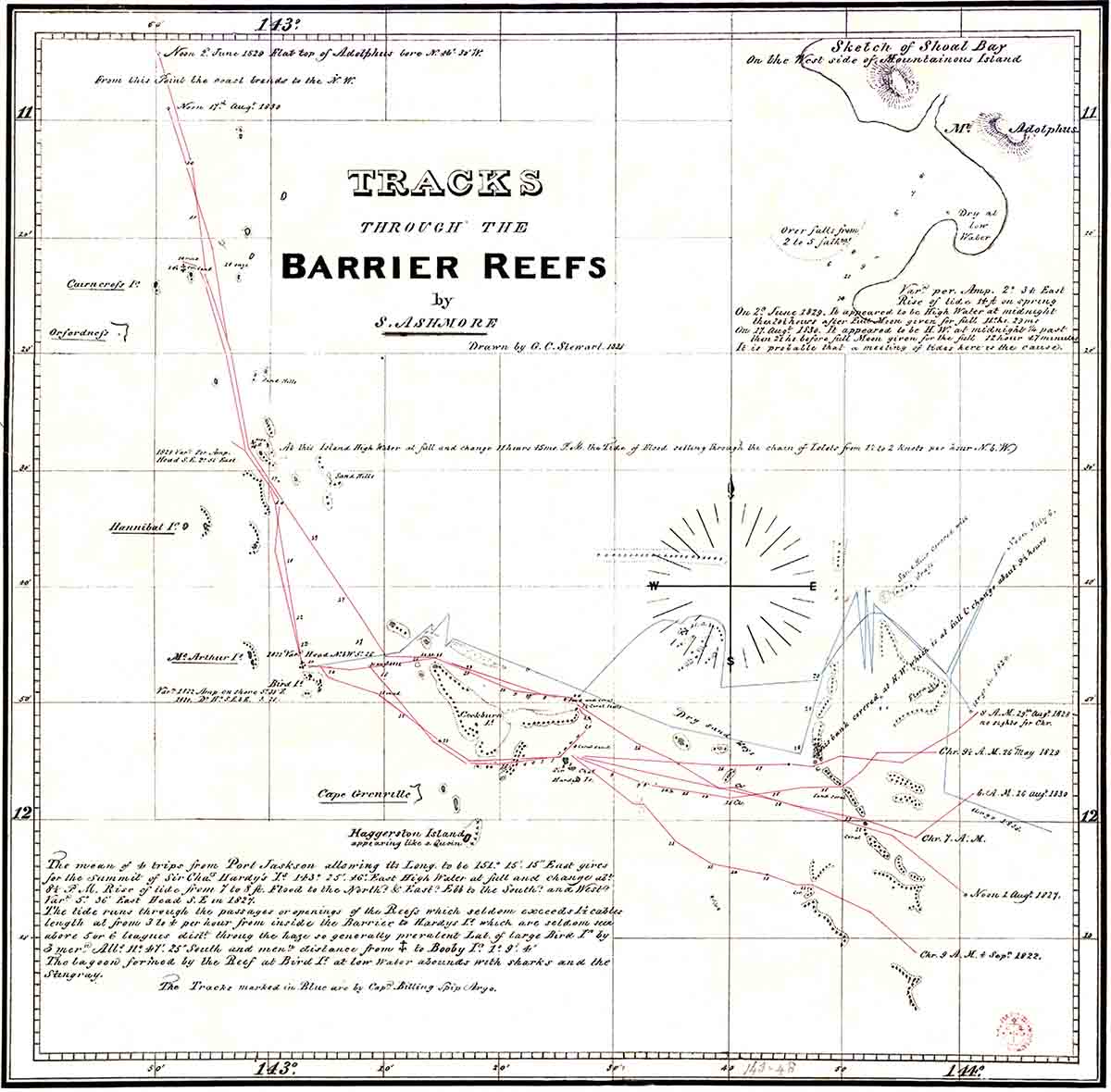
Ashmore had placed the southern end of the Great Detached Reef on approx. latitude 11° 50′ S., but its longitude is to the west of 144°E. It, too, is dangerously misleading. However, most ship’s masters at that time were not skilled at reading longitude and would have relied more on latitude readings and sightings with clear visibility.
Given that Ashmore’s chart wasn’t printed until 1835, it’s fair to ask: How did Captain Moore have a copy of it in 1834? He must have had either an early proof or a hand-drawn copy of a chart that Ashmore had done for his own private use. On it Ashmore has marked out five passages that had been safely used to cross through the Great Barrier Reef to the Torres Strait. Ashmore made the crossing nine times without incident. In Sydney in the 1830s it gave him an almost legendary status among seafarers. A few conscientious captains, wanting to use the outer passage but fearful of what lay ahead of them, sought information from Captain Ashmore on the best tracks through the Barrier Reef. Ashmore by this time had given up the seafaring life and settled in Sydney. He was generous with his free advice and even allowed a few of them to copy his chart. Captain Moore must have been one of them. It was precisely that kind of interest that encouraged Ashmore to pass his hand-drawn chart over to a Sydney draftsman to prepare it for printing. Before that happened though he laid down two more safe passages on it, supplied to him by the captain of the Argo, who safely traversed the reef as late as 1834. The fact that Moore had a copy of Ashmore’s chart in 1834 indicates his concern about the accuracy of the Horsburgh chart. His copy would not have been as clear as the printed version above.
In the wake of the subsequent disaster that befell the Charles Eaton, Ashmore was accused of producing a chart that was leading mariners to their destruction, by encouraging them to use the outer route to the Torres Strait instead of the inner route. Ashmore and his supporters could counter-claim that most masters of merchant ships already preferred the outer route and the chart helped most of them to avoid shipwreck. Both charts were misleading and when used together they were particularly confusing, but the onus was always upon each individual captain to approach the barrier reefs with extreme caution and to proceed through them only when visibility was very good. In the end, the much safer inner route laid down by Phillip Parker King RN should have been the obvious choice.
According to Captain Blackwood, R. N. who surveyed the reef in HMS Fly,
“A ship intending to enter the Barrier by the passage of Raine’s Island, should shape a course so as to make the southern extreme of a large detached horse-shoe Reef in lat. 11° 50′ S., long. 144° 11’E. ’ . . . Having sighted the breakers, which may be safely approached within a short mile, a north (compass) course will be steered along the outer edge of this detached reef, when this distance being run, Raine’s Island will be seen, and a N. W. by N. course should be shaped for it. (Sydney Morning Herald, 16 March, 1844).”
Great Detached Reef Google Map co-ordinates: Latitude : -11° 45′ 00”
Longitude : 144 01′ 00” (Tageo.com ). This would be a centre point with the reef extending from approx. Latitude : -11° 50′ 00” to approx. Latitude : -11° 40′ 00”.
Raine Island Entrance Google Map co-ordinates: Latitude : -11° 38′ 00”
Longitude : 144 00′ 00” (Tageo.com) This would be a centre point.
Yule Reef Google Map co-ordinates: Latitude : -11° 57′ 00”
Longitude : 143 57′ 00” (Tageo.com). This would be a centre point.
… HOME PART 1: PART 2: PART 3 PART 4 PART 5: PART 6 PART 7: ABOUT ME

You must be logged in to post a comment.